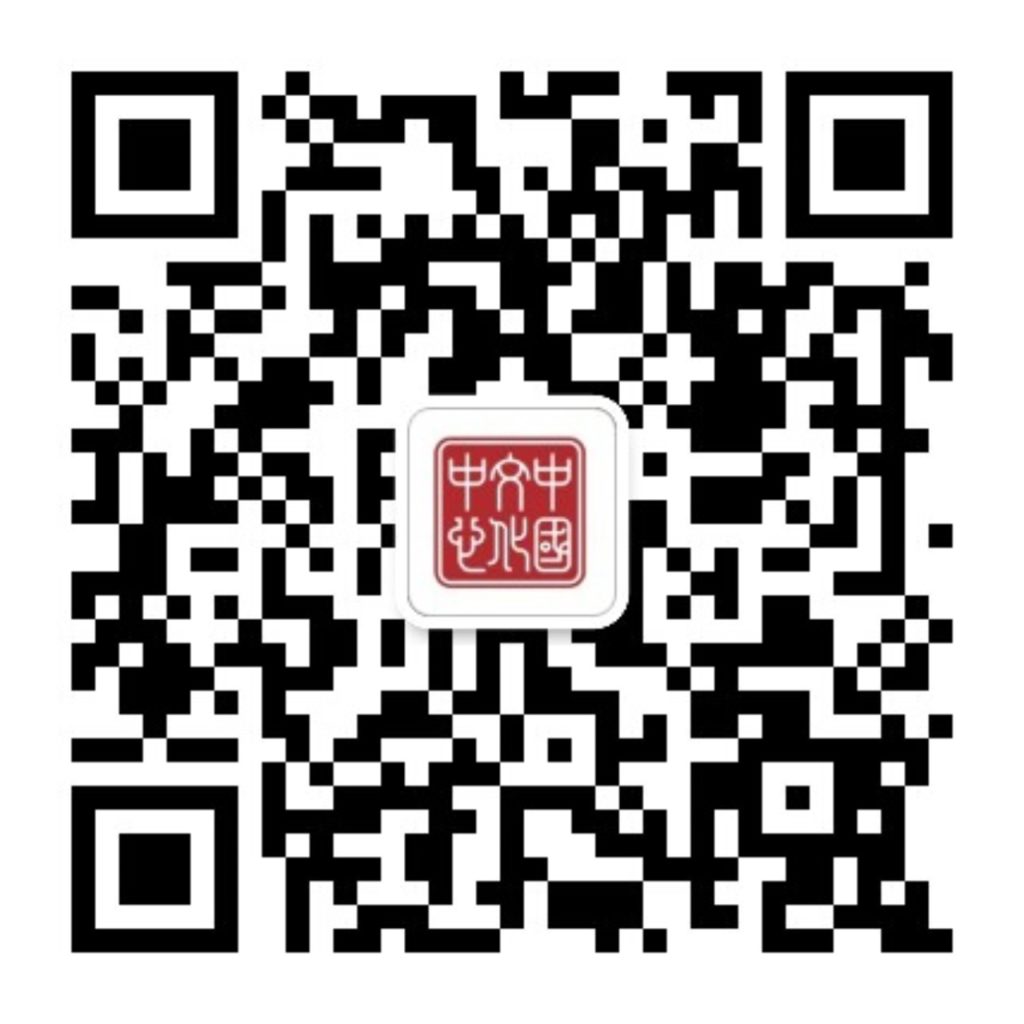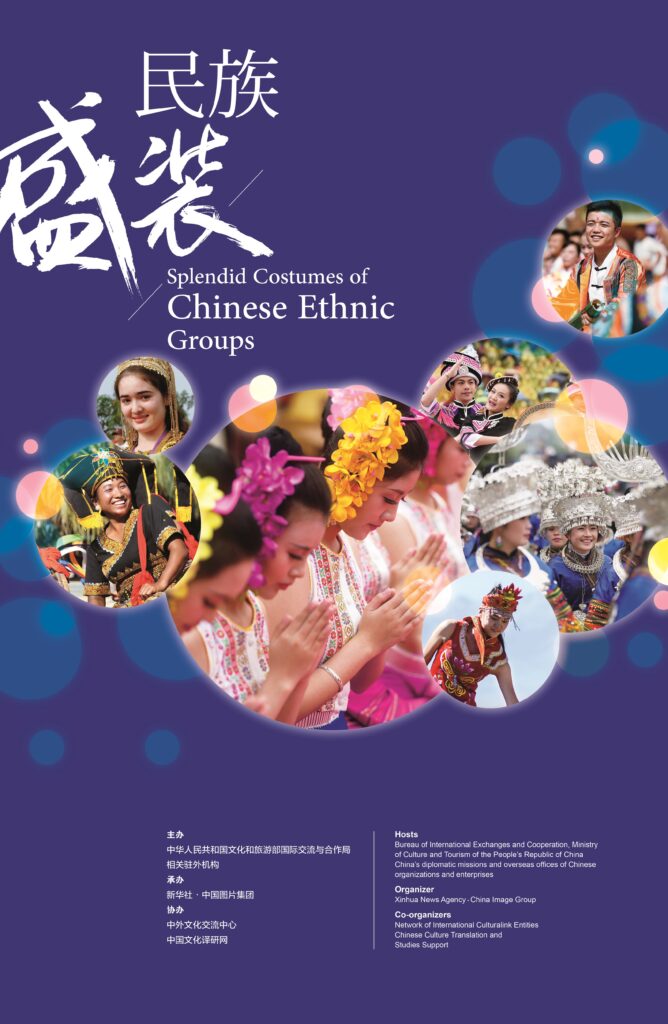
Clothing is a key element of human life and a symbol of human civilization. As a representation of society and culture, clothing not only shows material civilization, but also symbolizes spiritual civilization. Since the day when clothes were put over the body, people have already embedded in them their lifestyle and customs, aesthetic taste, preference of colors, cultural mentality, and religious concepts. China is a big family composed of 56 ethnie groups. Their costumes, each with its own characteristics, shine across the wonderful land of China like 56 strokes of beautiful colors, drawing together a new picture of Chinese costume.
The elegant Han costume, the rough Mongolian robe, the stunning Miao headgear, the delicate Yi embroidery, the gorgeous Zhuang fabric, the dazzling Kazakh hat, the multicolored Tu sleeves, the mysterious Salar hijab, the extraordinary De’ang waist band, etc. With splendid costumes of Chinese ethnic groups, this exhibition presents to visitors a magnificent picture of the historical changes, economic development, and cultural evolution of the Chinese nation, showcasing a harmonious China whose ethnic groups stand in unity and whose culture preserved in diversity.
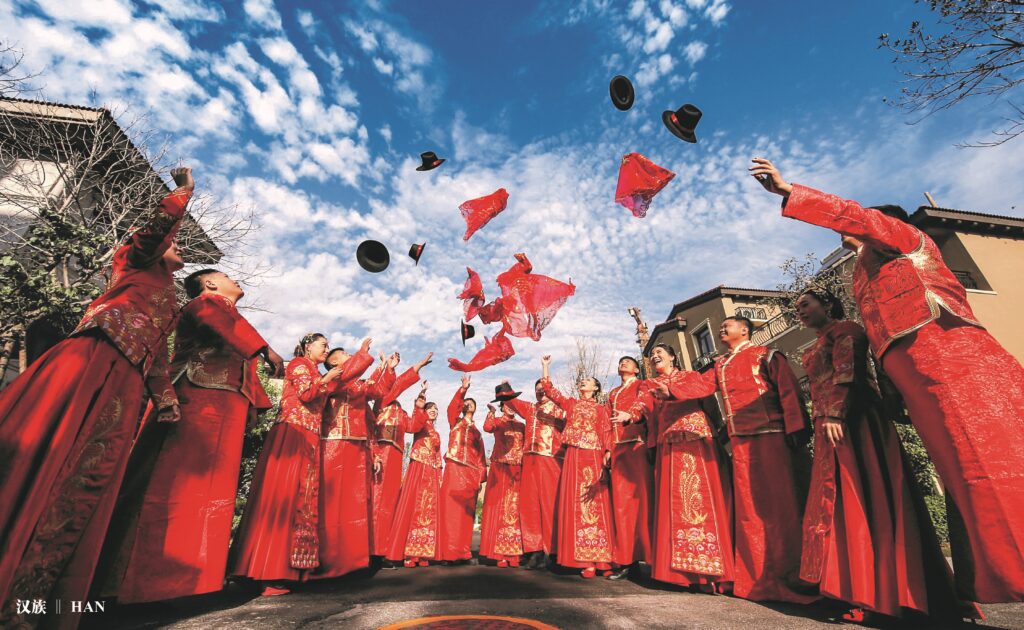
The Han population is formed during the course of history by the migration, assimilation and integration of multiple ethnic groups from multiple regions, and has a very complex system of cultural beliefs. For most of dynasties, the traditional culture is mainly centered on three beliefs: Confucianism, Taoism, and Buddhism, advocating elegance, moderation, magnificence, and inclusiveness. In the history, the court, the nobility, and the folk all have rich and colorful costumes and accessories made with various techniques. The Han people love red and often use it as the main color of the festival costumes. Han costume is a wide robe with big sleeves, with the collars diagonally crossing each other and the right lapel underneath the left. With a history of more than 2000 years, it is not only commonly seen in costume films and TV dramas, but also deeply loved in contemporary life. (Photo by Liu Qinli, Xinhua News Agency)
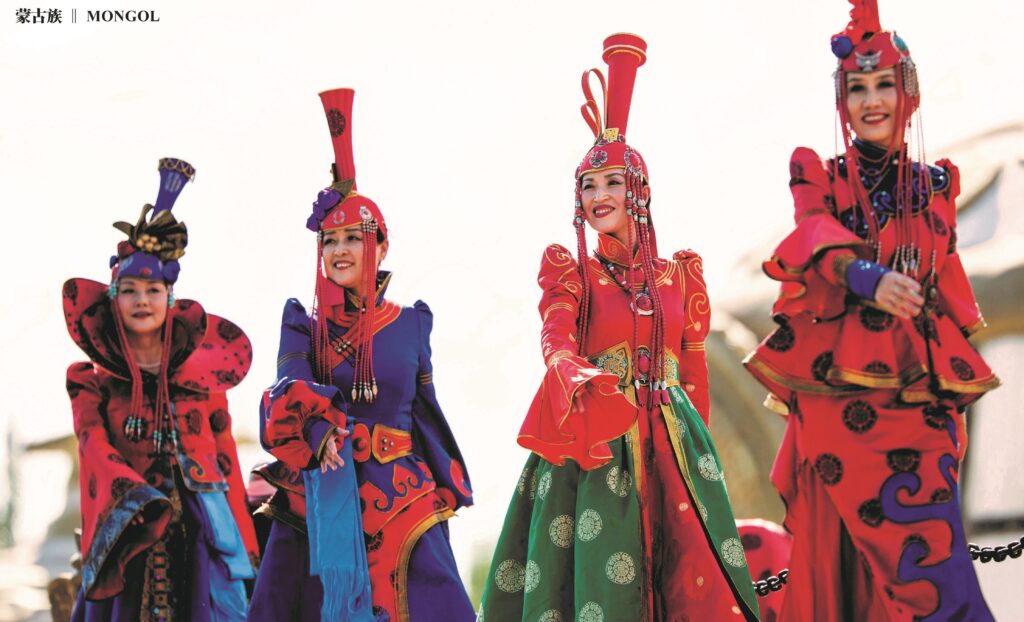
The Mongolian people in China live mainly in the Inner Mongolia Autonomous Region. Their traditional beliefs include Shamanism, Buddhism, and Islam. The Mongolian people have been living on the grassland for generations, leading a nomadic life of “following water and grass”. They are good at singing and dancing, and their traditional costume has a strong grassland touch – predominantly robes that are comfortable to wear on horses, with vivid colors, broad silhouettes, and red or green belts made of silk or satin. (Photo by Ding Genhou, Xinhua News Agency)
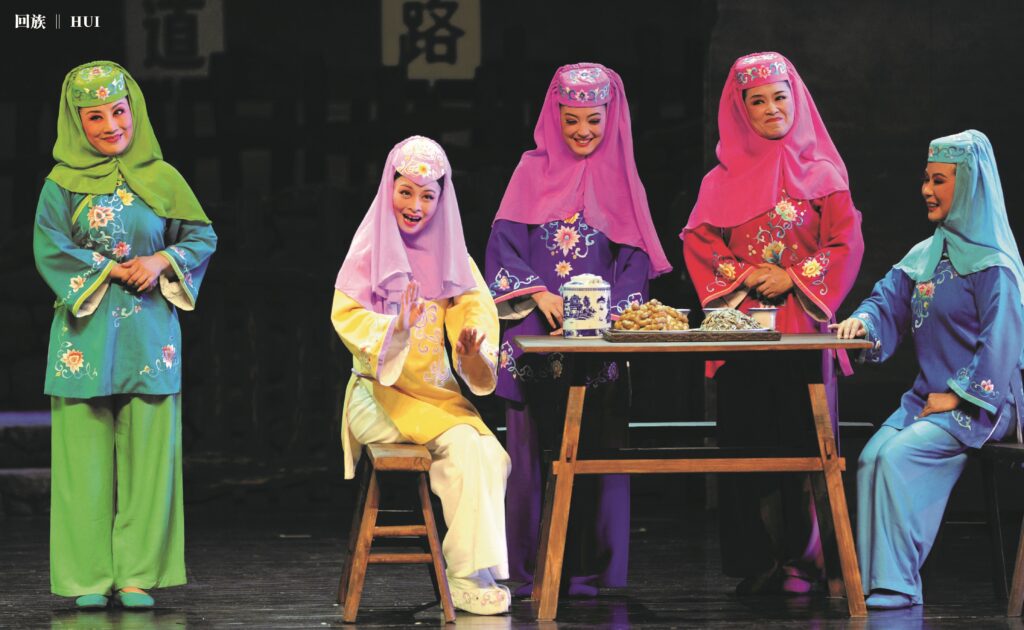
In China, the Hui people are “largely scattered in small compact communities”. They inhabit mainly the Ningxia Hui Autonomous Region. In the past, they believed in Islam, but have localized the religion by adding rich local colors to it. Take the headgear as an example. Men of the Hui ethnic group usually wear white round caps, but like to add embroidery and other decorations. Women often wear hijabs, but tend to choose bright and natural colors. The material varies from silk, satin to crepe georgette, reflecting strong features that are considered Chinese or secular. (Photo by Wang Song, journalist of Xinhua News Agency)
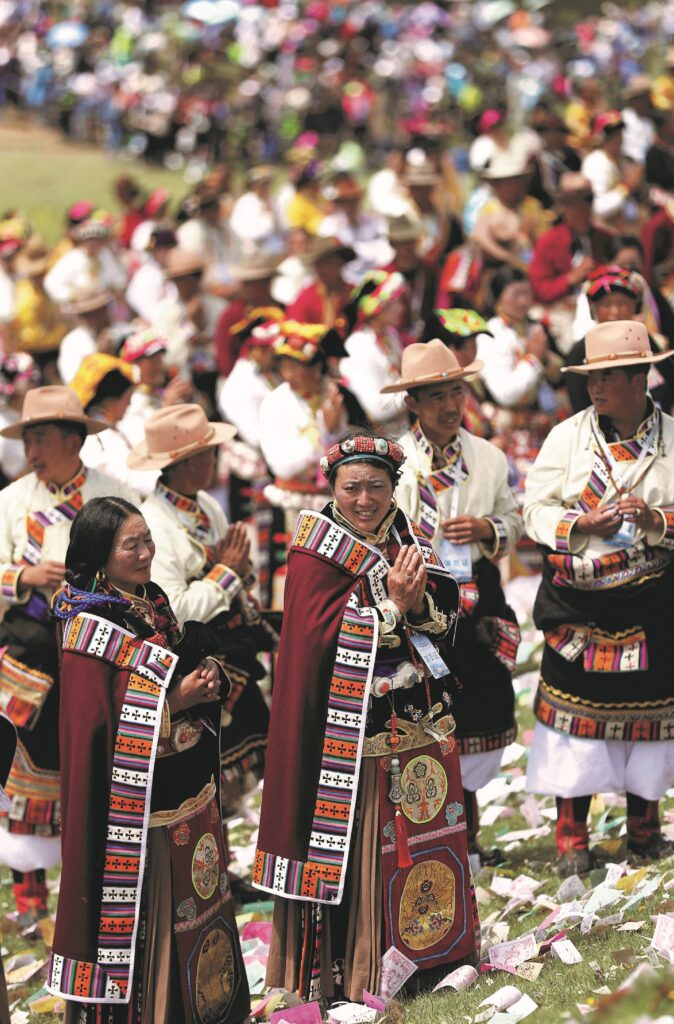
In China, Tibetans, the indigenous people of the Qinghai-Tibet Plateau, inhabit mainly the Tibet Autonomous Region, Qinghai Province, the west of Sichuan Province, Diqing in Yunnan Province, and Gannan in Gansu Province. Over the past one thousand years, the Tibetan people have created a splendid ethnic culture, with rich heritage and achievements in medicine, architecture, literature, music, dance, painting, and sculpture. Because of the cold weather and high altitude of where they live, Tibetans wear mostly felt and cashmere. The basic characteristics of their clothes are long sleeves, wide waist line, long dress and long boots, with gold or jade jewelry as accessories. (Photo by Jiang Hongjing, journalist of Xinhua News Agency)
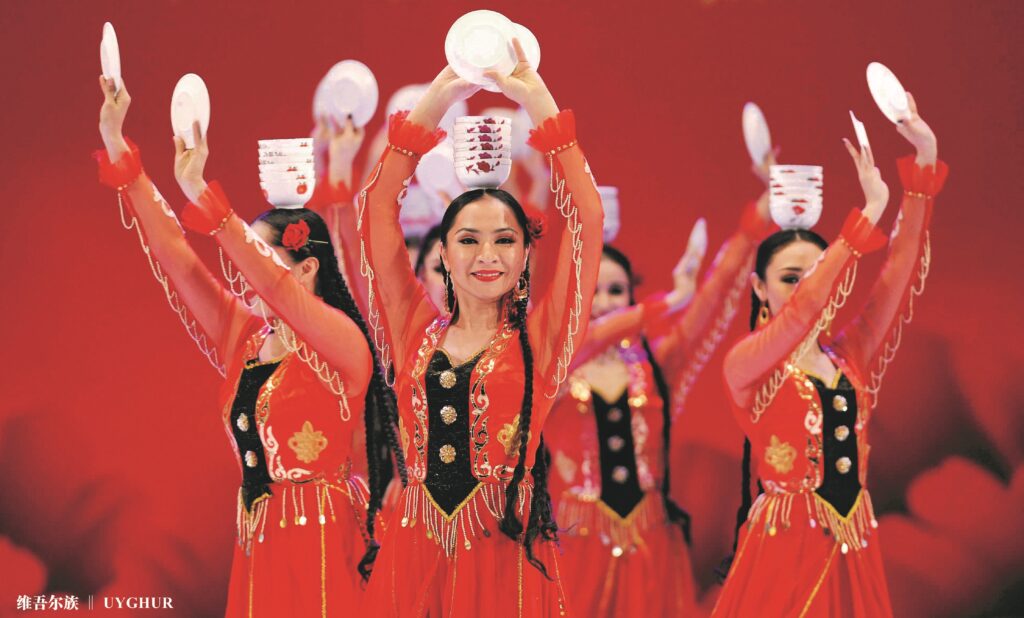
Uyghurs in China live mainly in Xinjiang Uyghur Autonomous Region. In the long process of historical development, the Uyghur people have formed unique ethnic costumes. They are good at singing and dancing, handicrafts and other skills. In terms of traditional costumes, Uyghur men are dressed in chapan (overcoats) with belts around the waist. Women usually wear dresses with jackets or blouses. (Photo by Shadati, jounalist of Xinhua News Agency)
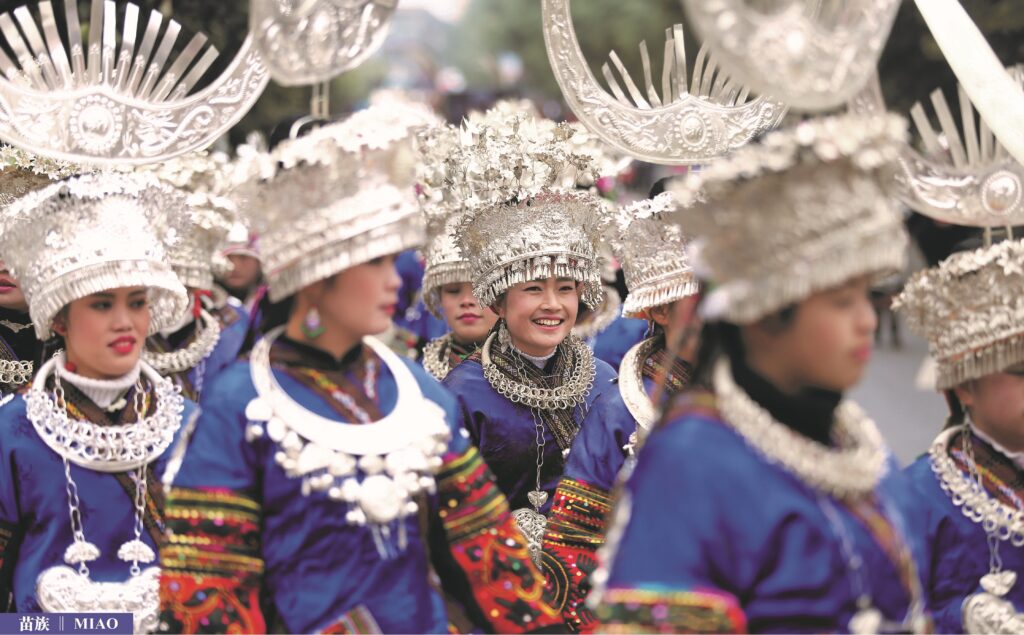
The Miao people inhabit mainly Guizhou, Hunan, Guangxi, Yunnan, Sichuan, and other provinces and regions in China. Its ancestors first lived in the middle and lower reaches of the Yellow River, and later, due to war and other reasons, moved to the mountainous areas in the southwest as well as the Yunnan-Guizhou Plateau. In terms of traditional beliefs, the Miao people worship both Nature and Chiyou, one of the ancestors in the Chinese mythology. These beliefs form a unique and mysterious tribal culture that manifests in particular in religious rituals and ethnic costumes. Their clothes are of varied styles and gorgeous colors. The Miao people are known for their silver jewelry. They have dozens of types of hair accessories just to decorate the bun on the head when they dress up in traditional costume. (Photo by Tao Liang, journalist of Xinhua News Agency)
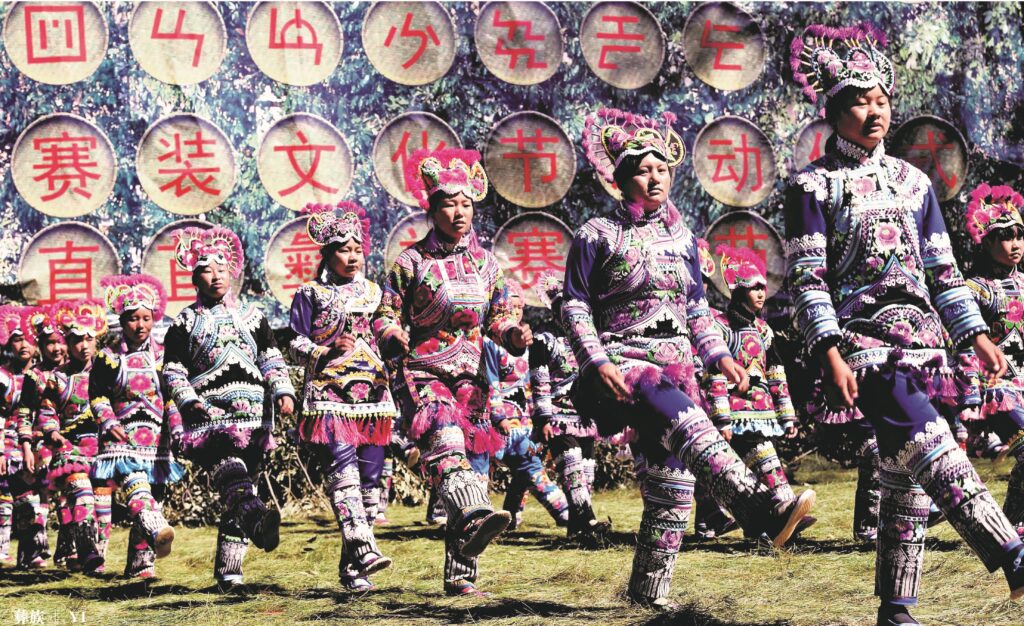
The Yi people inhabit mainly between the plateaus and coastal hills of Yunnan, Sichuan, Guizhou, and Guangxi Province. Liangshan Yi Autonomous Prefecture is their largest community in China. Their traditional beliefs, which are deeply influenced by the concept of animism, include the worship of natural gods, totems, and ancestors. Since this ethnic group has multiple branches, it turns out that there are many types of Yi costume, all of which are heavily decorated with silver ornaments and embroideries. (Photo by Yang Zongyou, journalist of Xinhua News Agency)
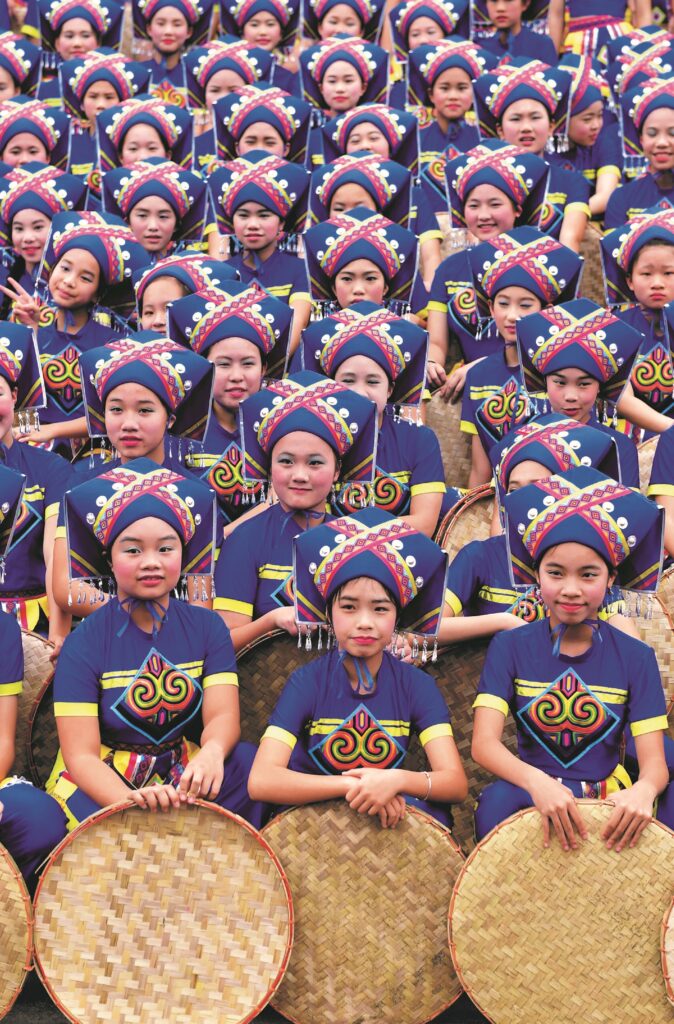
Zhuang is the most populous ethnic minority in China. They live mainly in the south and Guangxi Zhuang Autonomous Region is their main compact community. Zhuang’s culture and art are rich, diverse, and of a long history. Their traditional folk belief is polytheistic. Zhuang women are good at weaving and embroidery. The Zhuang cloth and Zhuang brocade are known for their exquisite patterns and bright colors. (Photo by Huang Xiaobang, journalist of Xinhua News Agency)
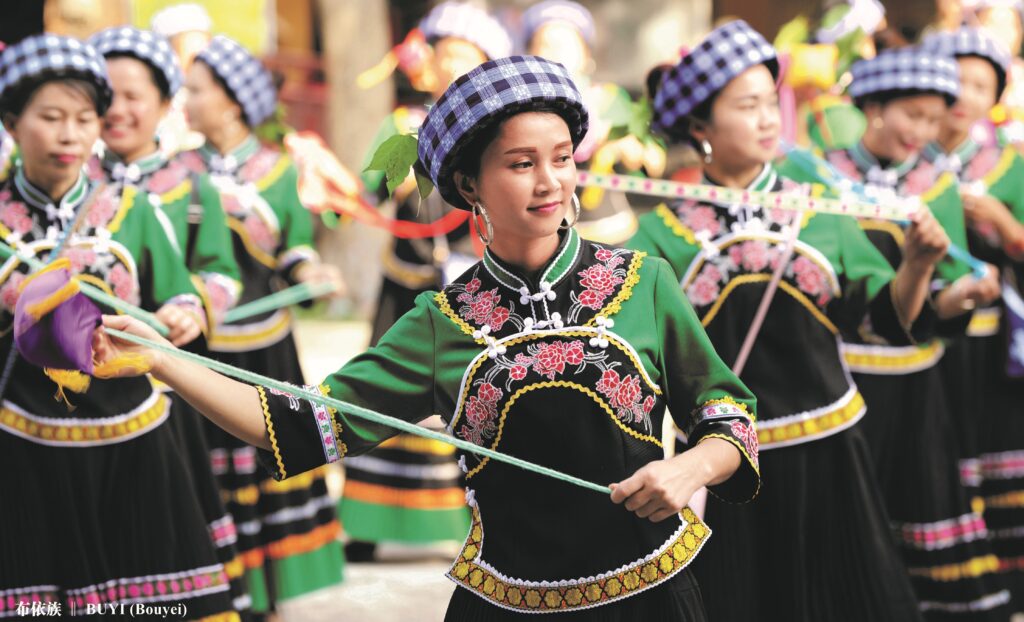
Inhabiting mainly Guizhou, Yunnan, and Sichuan Province, Bouyei is a large minority group in southwest China. They have traditional beliefs of ancestors and various gods. Their culture and art are rich and diverse, and their handicrafts, such as textile, batik, embroidery, bamboo weaving, and sculpture, enjoy a high reputation. Bouyei costumes are mostly turquoise, blue, and white, featuring homemade brocade and batik. (Photo by Yang Wenbin, Xinhua News Agency)
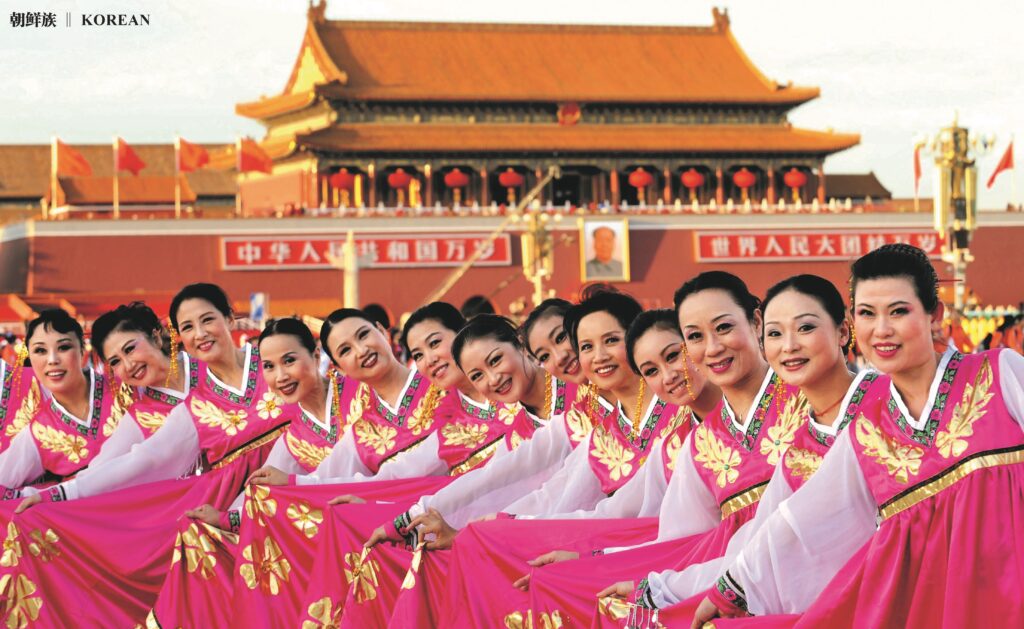
The Korean ethnic group in China inhabit the three northeastern provinces: Jilin, Heilongjiang and Liaoning. In the long course of history, the Korean people have created life styles, customs, and cultures that suit their own survival. The colors of Korean costumes are either simple and elegant or bright and lively. Koreans are called “white-dress ethnic group” for their preference of the color white. Korean women usually wear short tops and long dresses, and men are dressed in short tops and loose pants. Men also wear robes as a ceremonial attire. (Photo by Wang Song, journalist of Xinhua News Agency)
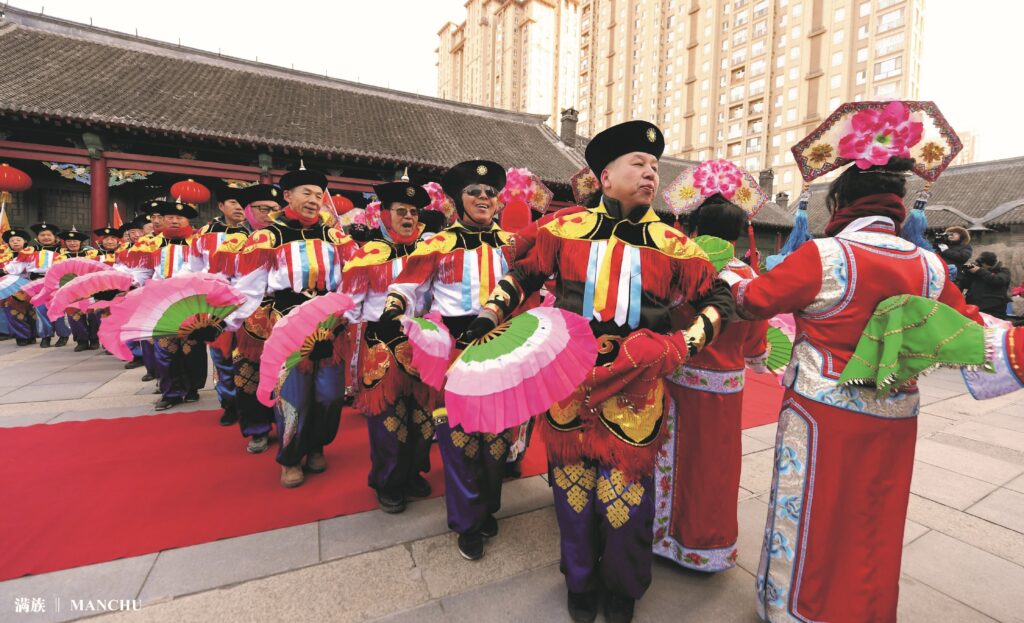
Manchu people rank the second in population among the ethnic minorities and live all over the country mainly in Liaoning, Hebei, Heilongjiang, Jilin, Inner Mongolia Autonomous Region and Beijing. They are renowned for staying open to foreign cultures, being able to integrate different cultures and enrich their own. Manchu men wear robes slit at both sides, with belts around the waist to make it easy for riding and shooting. Women wear loose, straight cheongsams. After Manchu people entered the hinterland, Manchu and Han costumes have gradually assimilated and women’s cheongsam has evolved into a symbol of the traditional costume for Chinese women. (Photo by Zhang Nan, journalist of Xinhua News Agency)
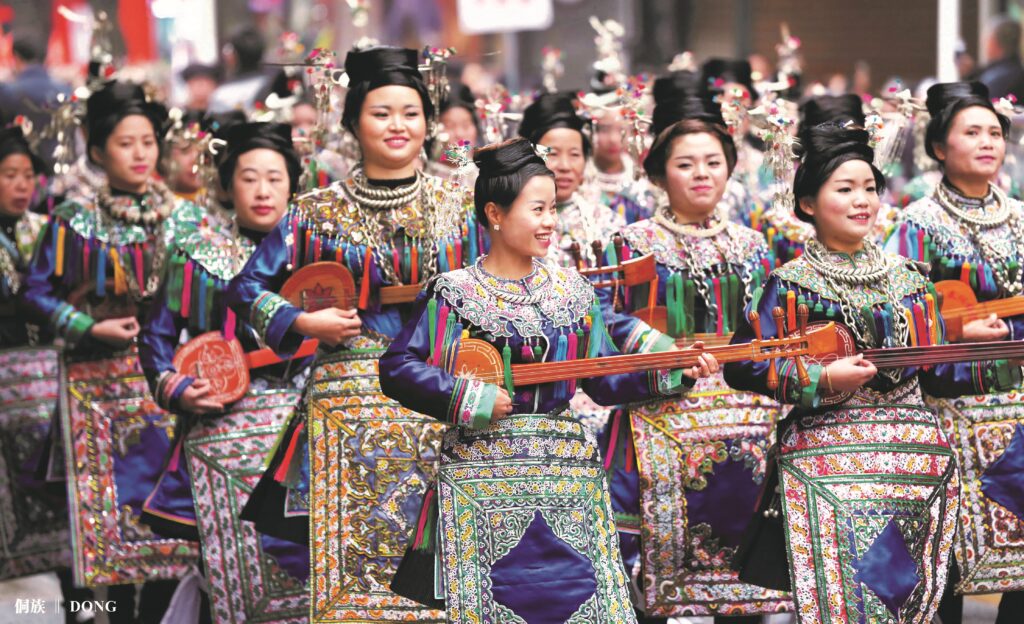
The Dong people live mainly in Guizhou, Hunan, Guangxi, and Hubei. Since ancient times, they have built villages near mountains and rivers, where men cultivate and women weave. Their traditional belief is polytheistic. Some ancient rituals and lifestyles are well inherited and are still in practice. The Dong costume is diverse in style, with silver ornaments as their main decoration. (Photo by Wu Jibin, Xinhua News Agency)
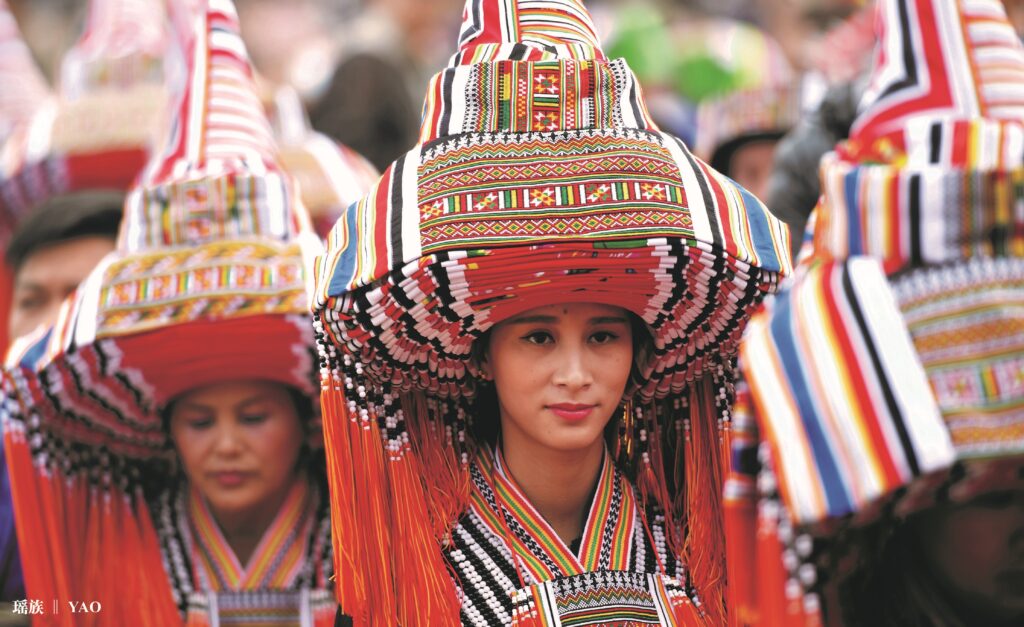
The Yao people inhabit mainly the mountainous areas of Guangxi, Hunan, Guangdong, Yunnan, Guizhou and Jiangxi Province in south China. Since most of them live in Guangxi, people say ‘there is not a single mountain in the south that doesn’t house a Yao”. Due to the characteristics of Yao’s legend of origin, production mode, as well as way of living and clothing, there are more than 30 branches of this ethnic group: Hong Yao, Pan Yao, Guoshan Yao, Chashan Yao, Hongtou Yao, etc. In general, the Yao costume is gorgeous and splendid, especially the women’s clothing, which are mostly pleated skirts decorated with embroideries. (Photo by Zhang Ailin, journalist of Xinhua News Agency)
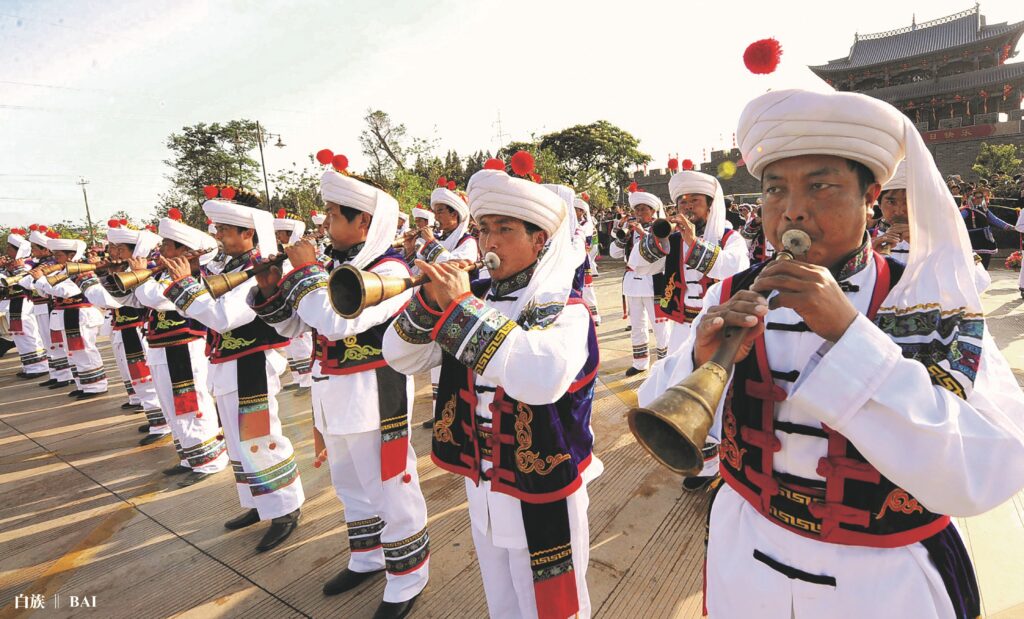
The Bai people live mainly in Yunnan, Guizhou, and Hunan, among which Yunnan has the largest Bai population. Dali Bai Autonomous Prefecture is their main compact community. The Bai people advocate white and consider white clothes as a sign of nobility. The traditional religion of Bai is the worship of its own master Benzhu, who is called Wuzeng in the Bai language and is the guardian of Bai villages. The Bai people have many festival activities, such as March Street, Benzhu Festival, Butterfly Fair, and Jianchuan’s Horse and Mule Fair, all of which have regional and ethnic characteristics. (Photo by Yang Zongyou, journalist of Xinhua News Agency)
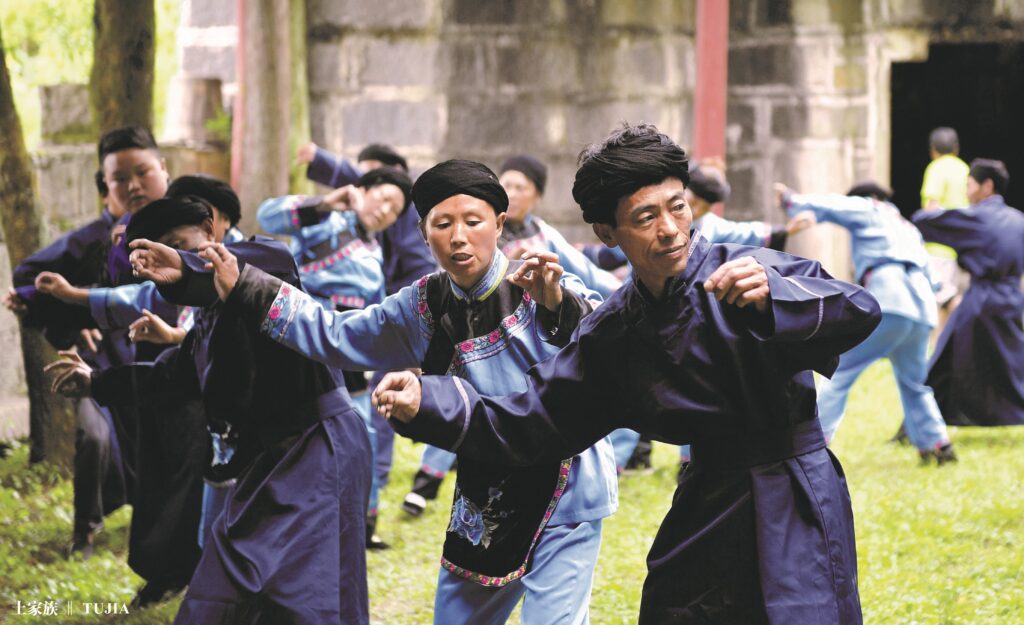
The Tujia people call themselves bizika, mijika or beijinka, meaning “native people”. They live mainly in the mountainous area of Wuling where Hunan, Hubei, Sichuan, and Guizhou provinces meet. The Tujia people believe in polytheistic religion and attach great importance to sacrificial ceremonies. Their clothes are simple and plain. Tujia women are good at spinning muslin and using their homespun blue cloth or linen to make clothes. The Tujia people are also good at dyeing, weaving, embroidery, carving, painting, paper cutting, and other folk crafts. (Xinhua News Agency)
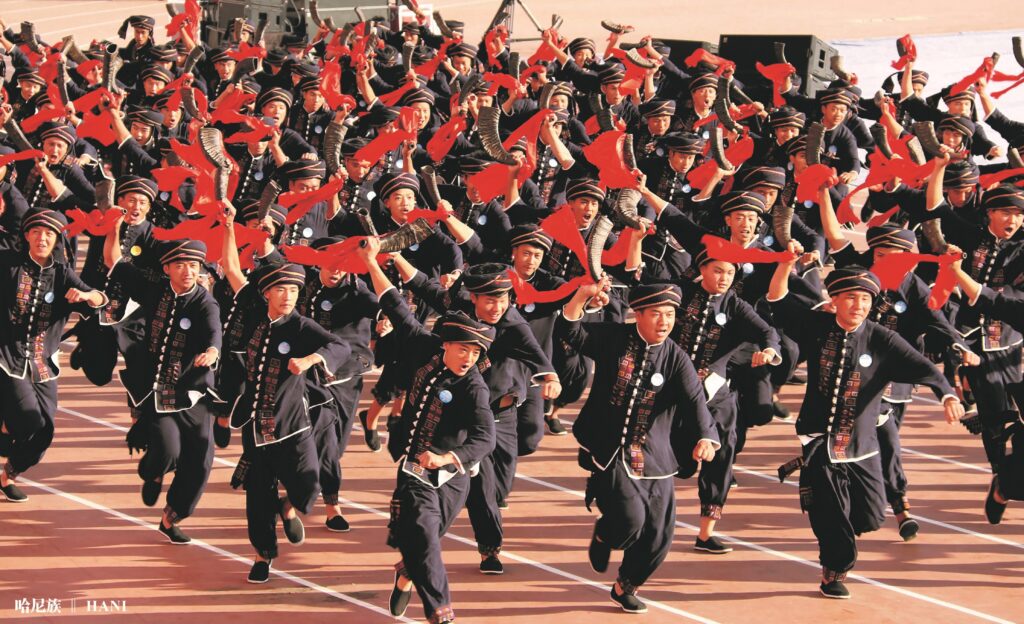
Most of the Hani people live in the middle of Yuanjiang River and Lancang River in southern Yunnan. It is their specialty and longtime tradition to take advantage of the natural conditions in the mountainous areas to cultivate terraced fields. Thus the famous landscape of Hani terraced fields was created. Embedded in the terraced fields is the long history and rich, extensive culture of the Hani people. Their clothes are usually made of blue and black cloth, dyed and woven by themselves. Hani men usually wear duijin coat with the left side of the front closure jointing but not overlapping with the right side, loose trousers, and turbans made of black cloth. Women’s clothes boast sophisticated styles and decorations. (Photo by Zi Qiang, journalist of Xinhua News Agency)
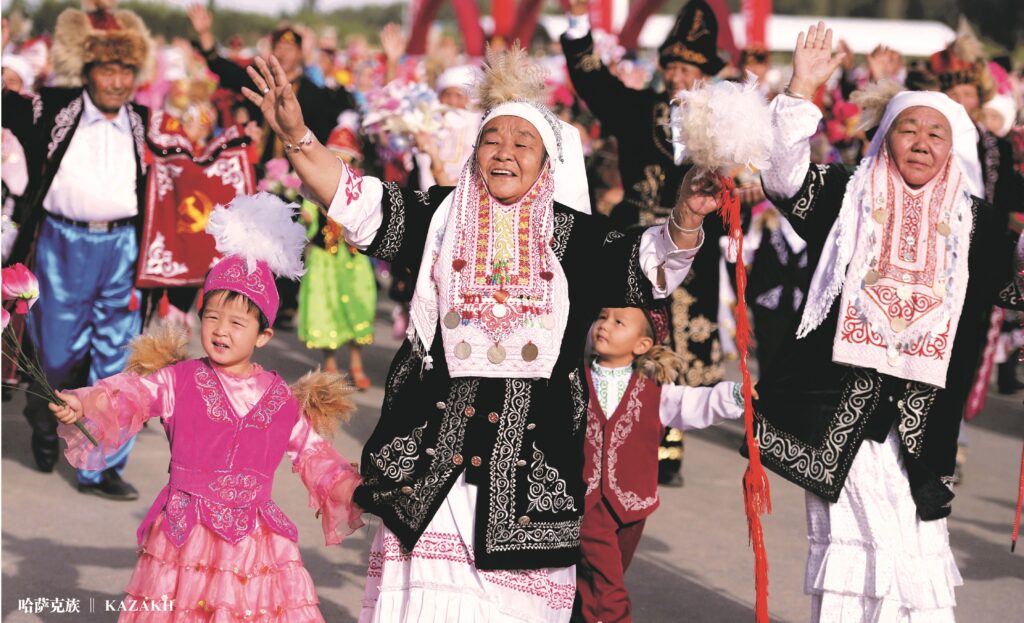
The Kazakh people in China live mainly in the Xinjiang Uyghur Autonomous Region. Their traditional beliefs include Shamanism and Islam. The Kazakh costume has a unique style. Tumake, a hat worn by Kazakh men in winter, can protect against wind, snow and cold. Women wear hats and headscarves, and girls grow up wearing Takeya – hat topped with auspicious owl feathers and glittering pearls. (Photo by Li Mingfang, journalist of Xinhua News Agency)
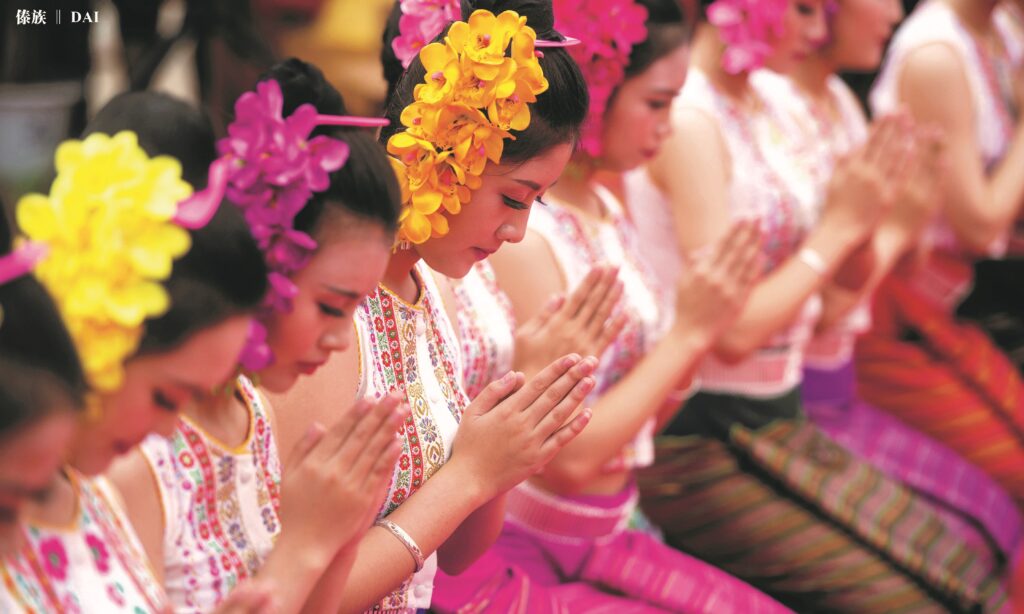
The Dai people in China mainly live in Yunnan Province. They live by water and are fond of water. Thus the are called “the ethnic group of water”. They regard peacocks and elephants as mascots and boast rich folk stories, various dances, and advanced medical science. Dai’s traditional beliefs include primitive religions and Buddhism. Dai costume is unique. Traditionally, women wear short tops with narrow sleeves and tube skirts. Men wear collarless tops with buttons down the front or short shirts with large fronts and small sleeves, and use white or turquoise cloth to wrap the head. (Photo by Hu Chao, journalist of Xinhua News Agency)
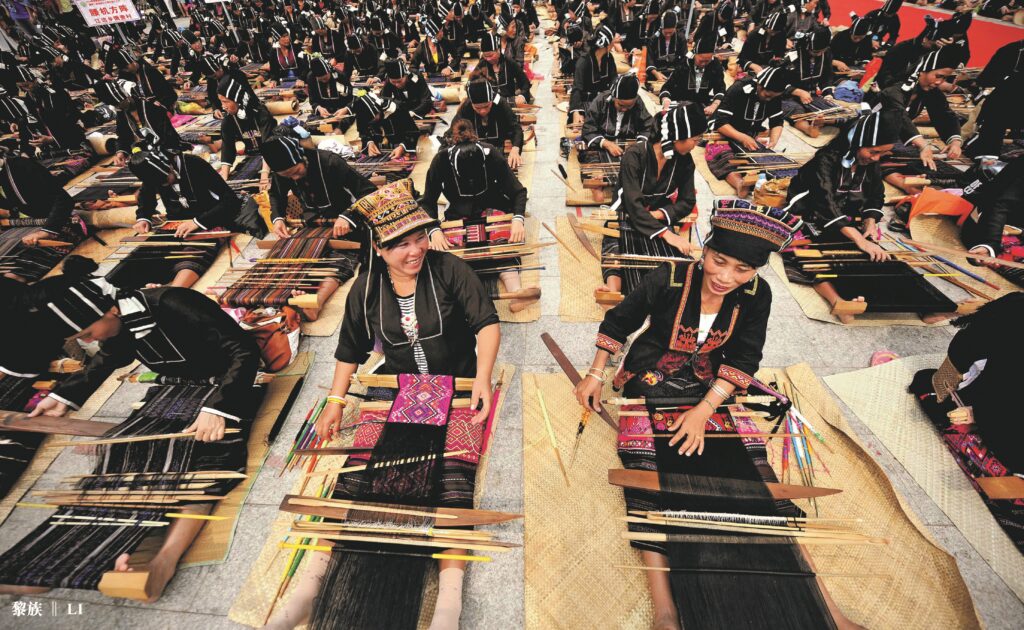
The Li people mainly live in Hainan Province and are the earliest residents of Hainan Island. Li women’s textile, especially the unique and original kapok textile, has long been famous in the world. The costumes of Li have a rich cultural connotation. Traditionally, Li women often wear duijin jackets, with the left side of the front closure jointing but not overlapping with the right side, with straight collar, no collar or no button, and tube skirts of different length. Men wear collarless top with front opening, with a loincloth underneath. (Photo by Guo Cheng, journalist of Xinhua News Agency)
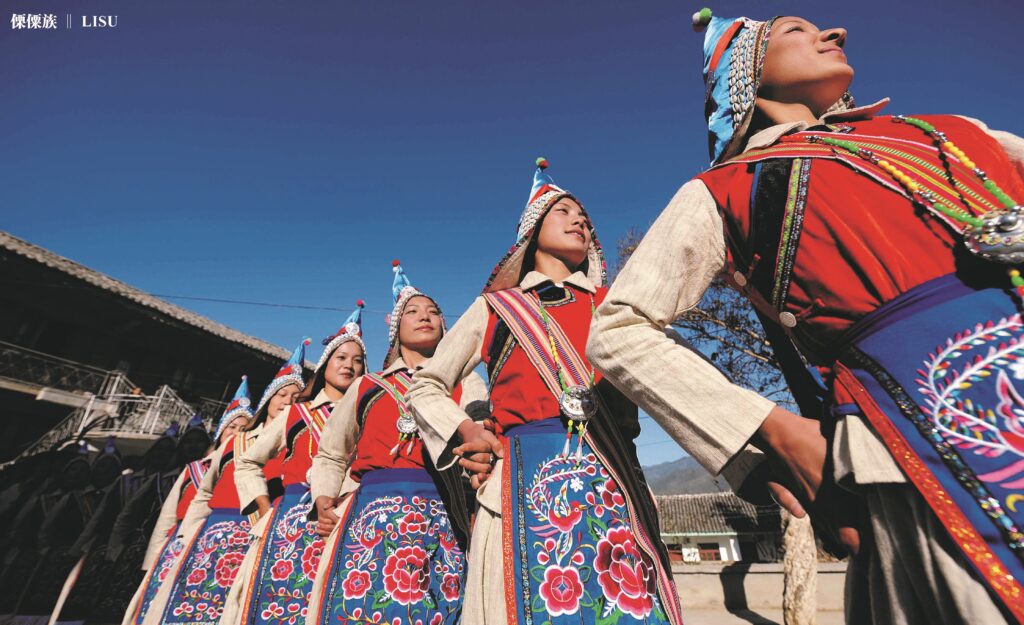
Lisu has its origin from the ancient tribes of Di and Qiang and is closely related to the Yi ethnic group. The Lisu people live mainly in Yunnan and Sichuan Province. Their traditional belief is a primitive religion that worships Nature and soul. Lisu’s traditional clothes are mainly made of linen. They vary in color and can be divided into three categories: black, white,and colorful Lisu. The artistic activities of the Lisu people mainly include singing folk songs and dancing. The most commonly used musical instruments are pipa (Chinese lute) and kouxian (jaw harp). (Photo by Lin Yiguang, journalist of Xinhua News Agency)
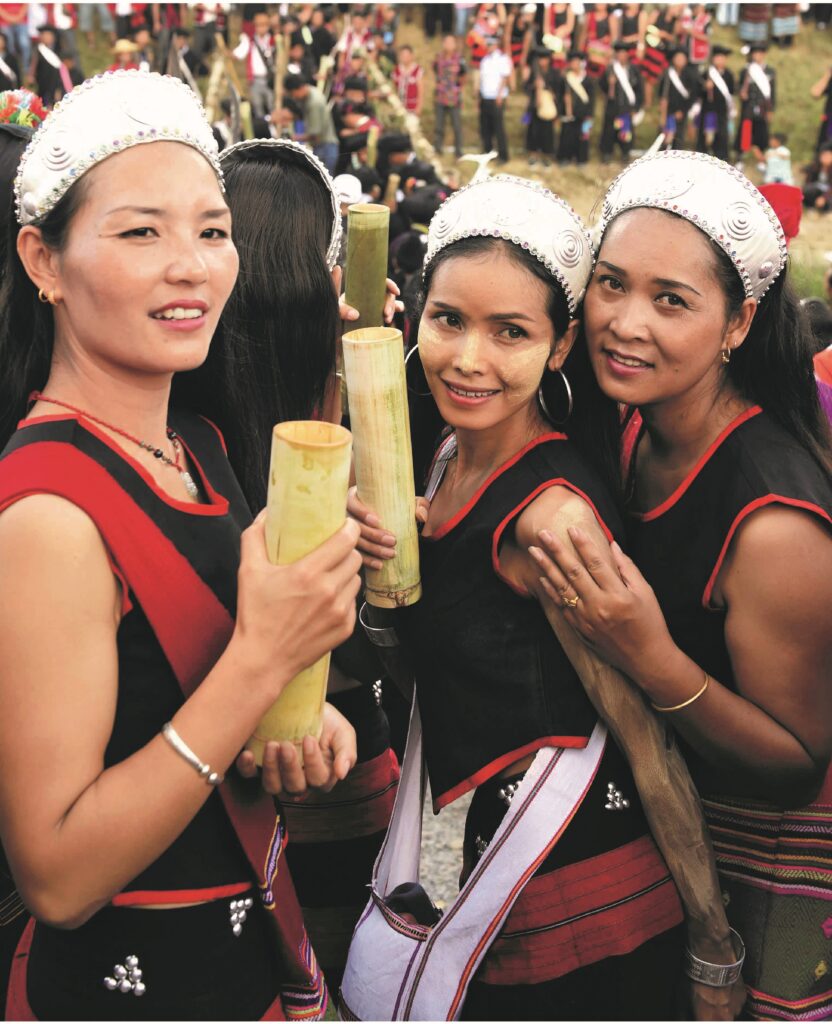
The Wa people mainly live in the southwest Yunnan Province, and their longtime interaction with Han, Dai and Lahu ethnic groups has promoted their economic development. Wa’s traditional religious beliefs include primitive religions and Buddhism. Their traditional festivals include the New Fire Festival, the Sowing Festival and the New Rice Festival. The first one is their New Year Festival. Traditionally, Wa men wear short, collarless tops and short, loose pants. Women wear short, black, collarless tops with folded tube skirts. (Photo by Yang Zongyou, journalist of Xinhua News Agency)
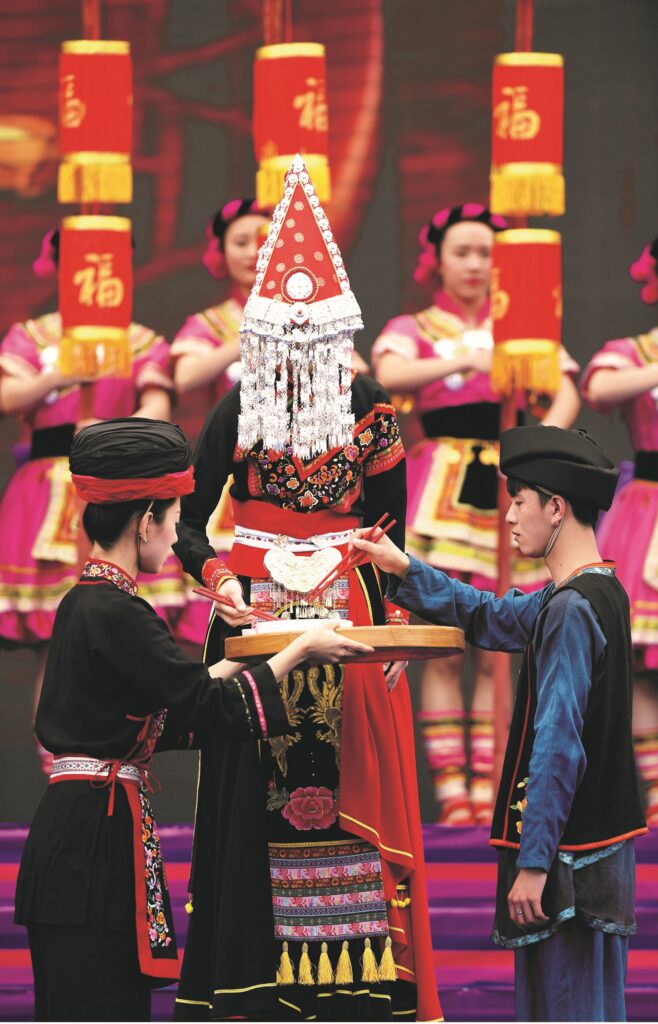
She is an ethnic group of shift farming in south China. For more than 1000 years, most of the She people migrated from Chaozhou (in Guangdong Province), their original place of residence, to Fujian, Zhejiang, Jiangxi, and Anhui to open up virgin soil and live in peace and contentment. In the process of migration, the She people have created colorful culture and art. Folk songs are a part of their working life, and there are also many types of handicrafts. The weaving skills, such as bamboo weaving, straw weaving and embroidery, are particularly well acclaimed. The traditional She costumes advocate turquoise and blue, and are mostly made of self-woven ramie fabrics. (Photo by Jiang Kehong, journalist of Xinhua News Agency)
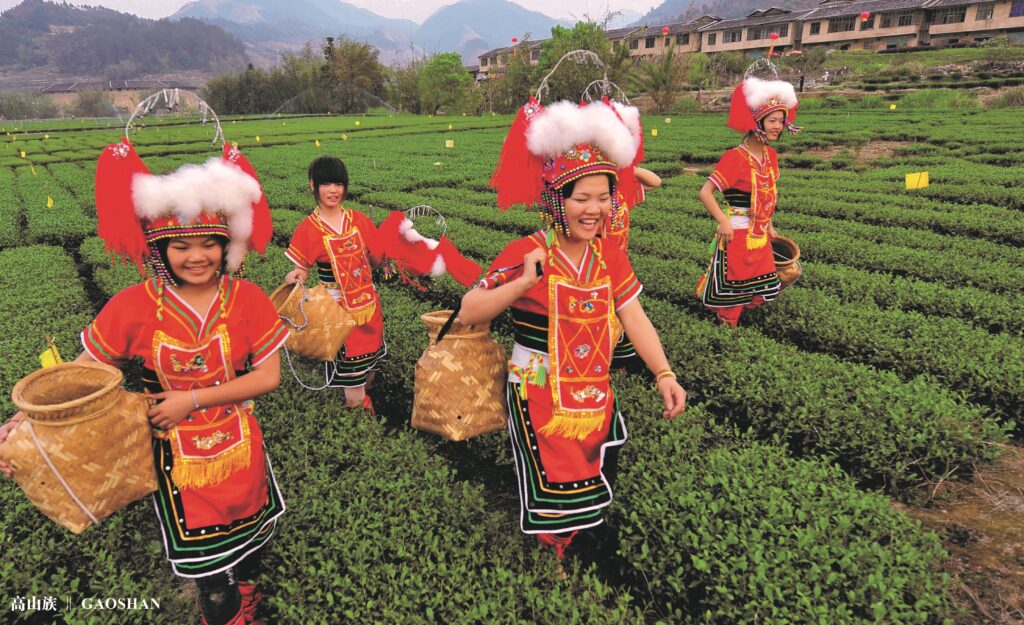
The Gaoshan people mainly live in Taiwan Province of China, with a few scattered in the coastal areas of Fujian and Zhejiang. Their economy is mainly rice-farming, supplemented by fishing and hunting. The handiwork of the Gaoshan people is mainly composed of weaving, bamboo weaving, rattan weaving, wood ripping, carving, bamboo cutting, and pottery making. Their costumes are splendid and colorful. Gaoshan women are good at dyeing and weaving all kinds of colored linens. They like to embroider exquisite patterns on the front, sleeves and headscarves, and they also like to use shells and animal bones to make accessories. (Photo by Wei Peiquan, journalist of Xinhua News Agency)
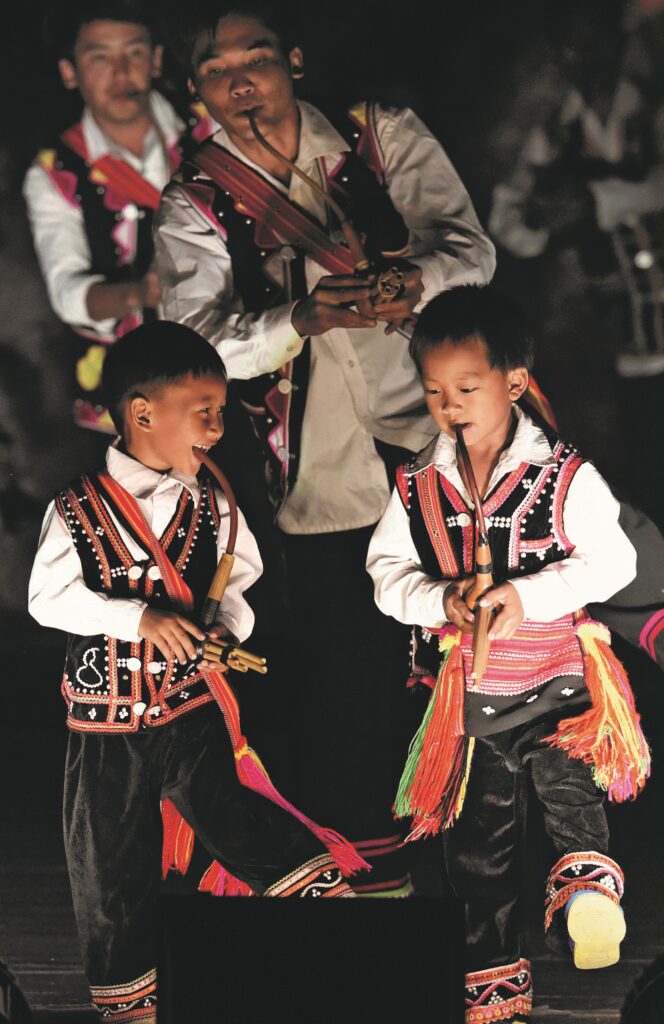
Lahu, one of the oldest ethnic groups in China, mainly live in the mountains of the Lancang River basin in Yunnan Province, and its traditional religion is polytheistic. They worship the great lord Ersha. Lahu’s traditional clothing features both the early nomadic culture of the north and the modern and contemporary farming culture of the south. The clothes are generally made of black cloth, trimmed with laces and patterns made of colored threads and cloths, and inlaid with white silver bubbles, making the outfit both somber and distinct with contrast. (Photo by Lin Yiguang, journalist of Xinhua News Agency)
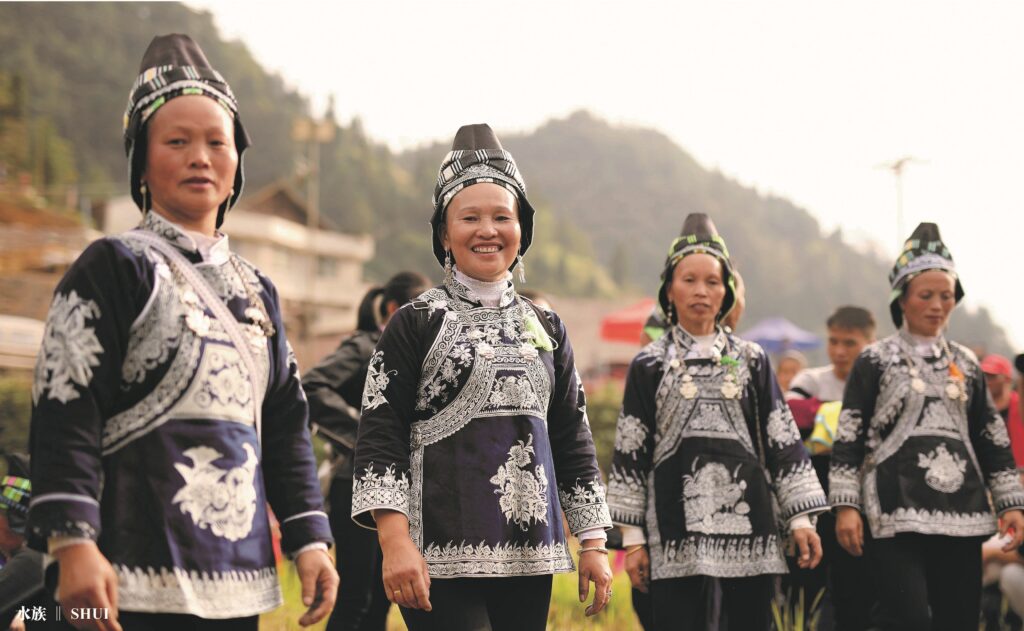
The Shui people inhabit mainly the upper reaches of Longjiang River and Duliu River along the border of Guizhou and Guangxi Province. With a long history, it still follows the ancient writing system of Shui writing, with compatible features of pictographic characters, hieroglyphs and abstract characters. Shui has many unique festivals, all of which closely linked with their history, calendar, farming culture, original beliefs, and habitation. The traditional costumes of the Shui people are self-spun, self-woven and self-dyed. Being dyed with self-made indigo is the main feature of their clothes. (Photo by Huang Xiaohai, Xinhua News Agency)
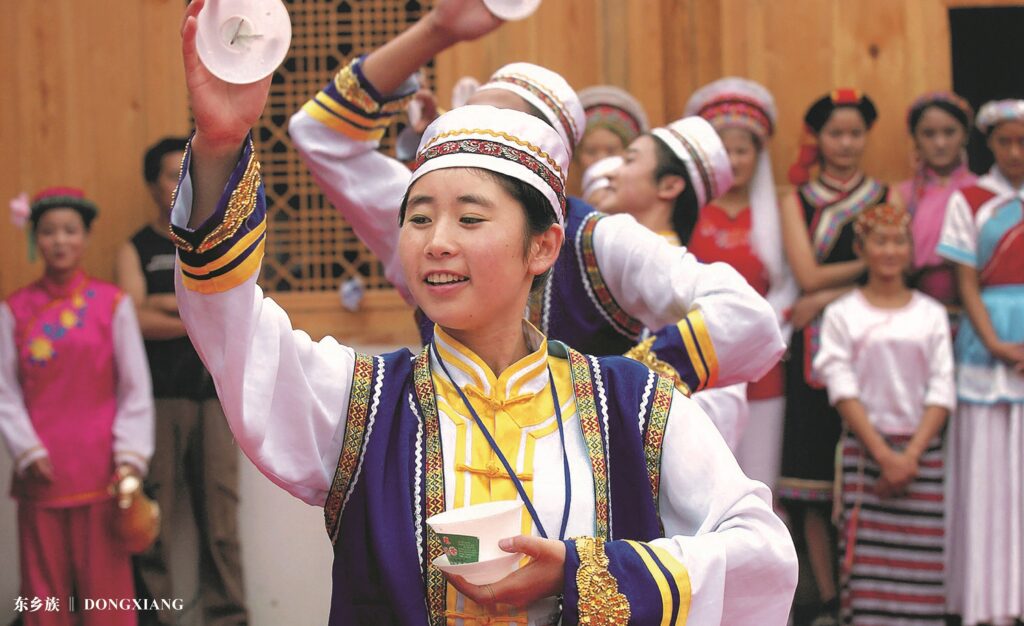
Dongxiang got its name from inhabiting mainly in Dongxiang, Hezhou (now Linxia of Gansu Province), and its origin was said to be the integration of the Huihui Semu, Mongol, and other ethnic groups. Its traditional belief is Sunni Islam. Almost everyone can sing and compose folk songs called Hua’er. In the past, Hua’er used to be mostly bitter songs and love songs. Nowadays, they become tributes of the new life. Dongxiang women generally wear hijabs and navy blue or black-blue dresses made of cloth. Men often wear wide robes, fastened by a wide belt to which they hang small items such as a knife or a pouch. (Photo by Zhang Xu, journalist of Xinhua News Agency)
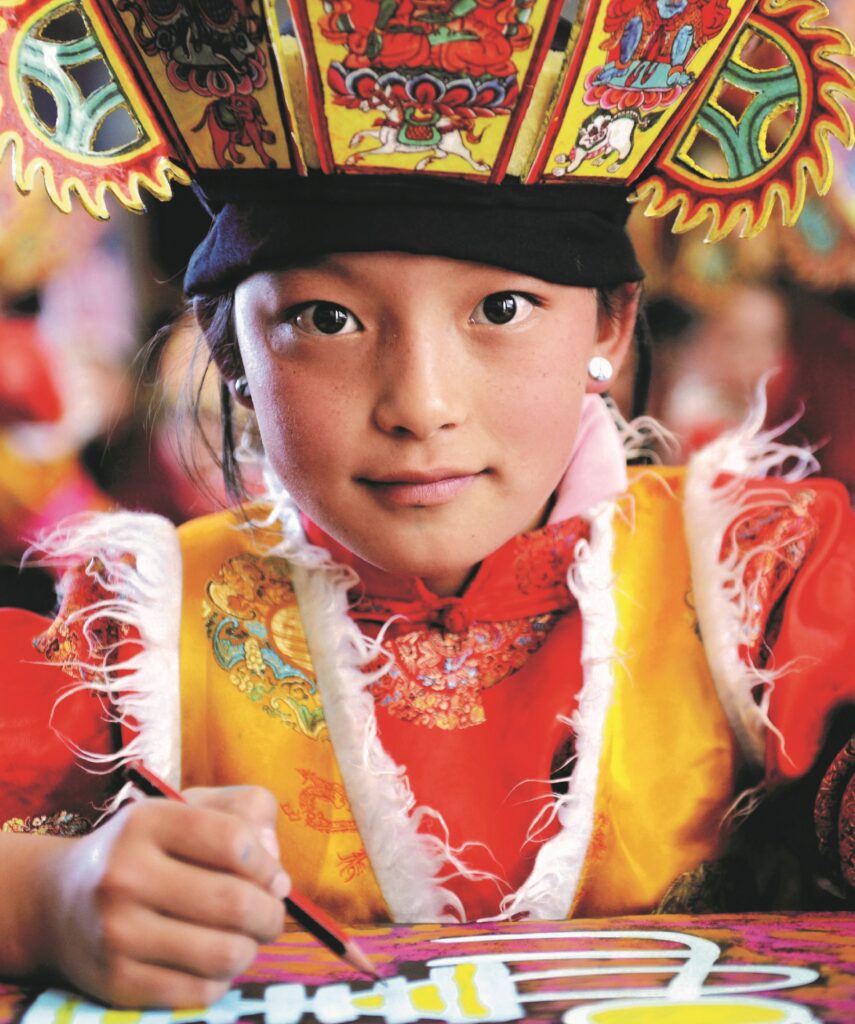
Most Naxi people live in Lijiang City in northwest Yunnan Province. Their traditional beliefs are the native religion of Dongba and Buddhism. The Dongba religion has great influence on the life of the Naxi people, and is preserved in various cultural forms such as rituals of the Dongba religion, Dongba language and Dongba sutra. The traditional Naxi costume seven-star cape has unique characteristics. It is made of a whole piece of black sheepskin, with patterns of the sun, the moon, and the seven stars embroidered on both shoulders. It is also called “wearing the stars and the moon”, a symbol of the hard work of Naxi women. (Photo by Wu Xiaoling, journalist of Xinhua News Agency)
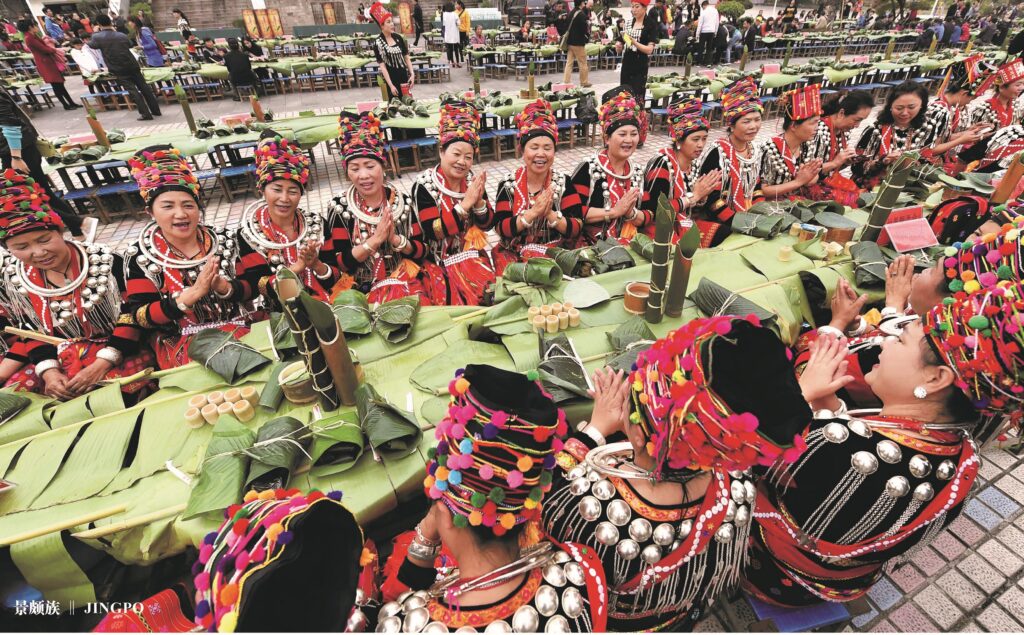
The Jingpo people mainly live in Dehong Dai and Jingpo Autonomous Prefecture of Yunnan Province. Their origin can be traced back to the ancient Di and Qiang people on the Qinghai-Tibet Plateau. There are five branches of this ethnic group: Jingpo, Zaiwa, Lechi, Lang’e and Bola. Jingpo has a unique style of clothing. Men are dressed mostly in black and white, carrying a tongpa (i.e. backpack) and a long knife. Women wear tops decorated with silver bubbles, silver plates, and silver tassels, colorful woolen tube skirts with beautiful patterns, and red jacquard scarves made of wool over their head. (Photo by Chen Haining, journalist of Xinhua News Agency)
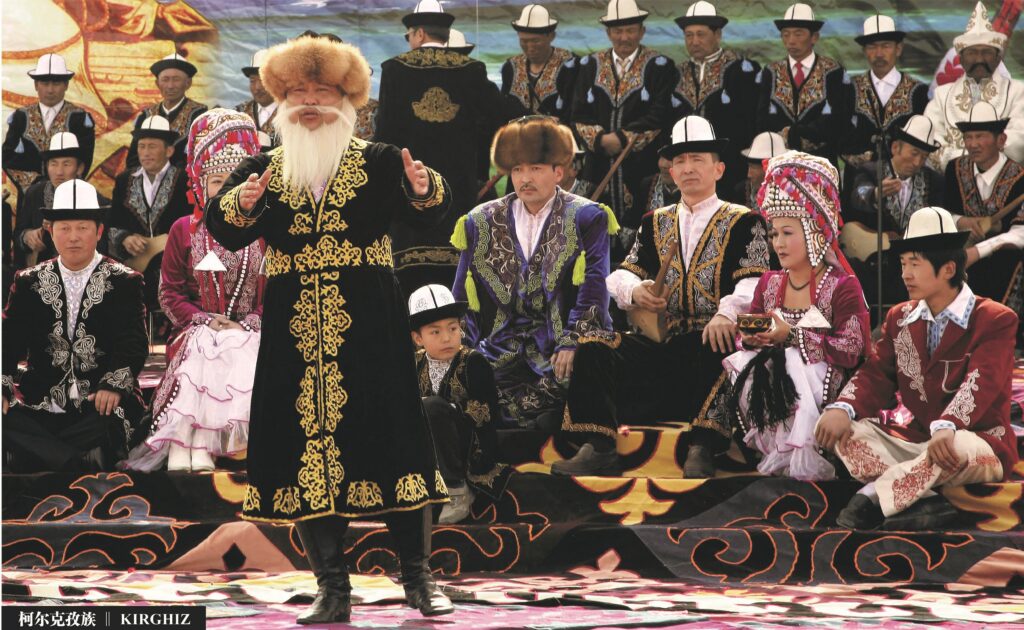
The Kirghiz people is also known as the Kyrgyz people out of China. They mainly live in the Kizilsu Kirghiz Autonomous Prefecture in the southwest of the Xinjiang Uyghur Autonomous Region. In the past, the Kirghiz people believed in Shamanism, most of whom nowadays believe in Islam. The Kirghiz people usually wear a small cap with its lower edge trimmed with a black cloth or black velveteen, and a fur hat in winter. Men usually wear band collar shirts embroidered with white lace, and women usually wear pleated long skirts and colorful pleuche vests. (Photo by Chen Peng, Xinhua News Agency)
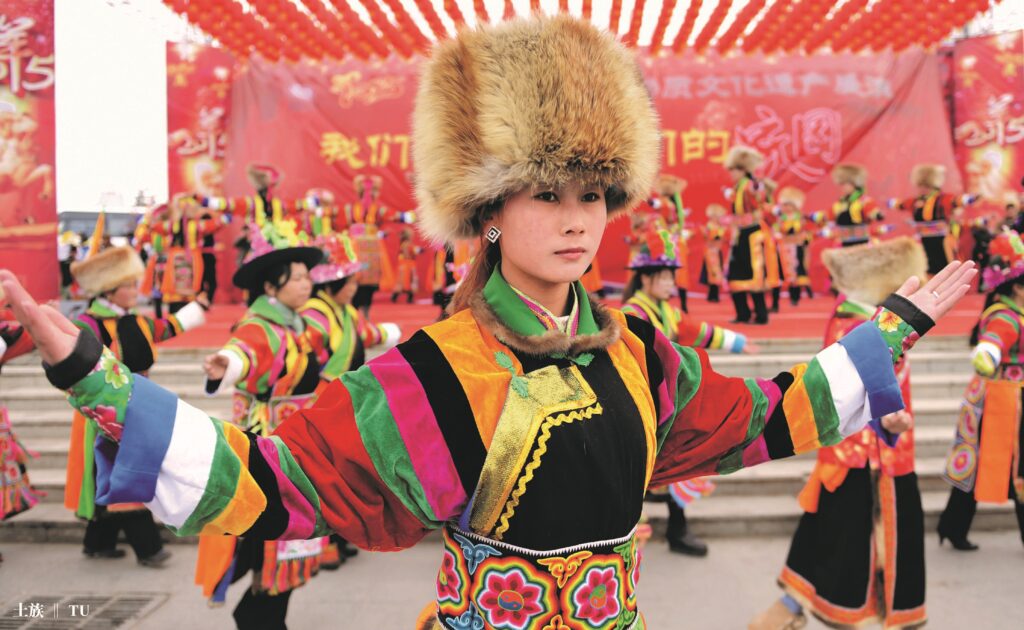
The Tu people is one of the ethnic groups with a small population in China, who mainly lives in the Huzhu Tu Autonomous County, Qinghai Province, with Buddhism as its traditional religion. The traditional costumes of the Tu people are brightly colored, the most distinctive feature of which is the colorful flower sleeves for women. They are made of cloth in five colors, which consist of red, yellow, green, turquoise, and purple. Women usually wear various Niuda (a local headwear). (Photo by Zhang Hongxiang, journalist of Xinhua News Agency)
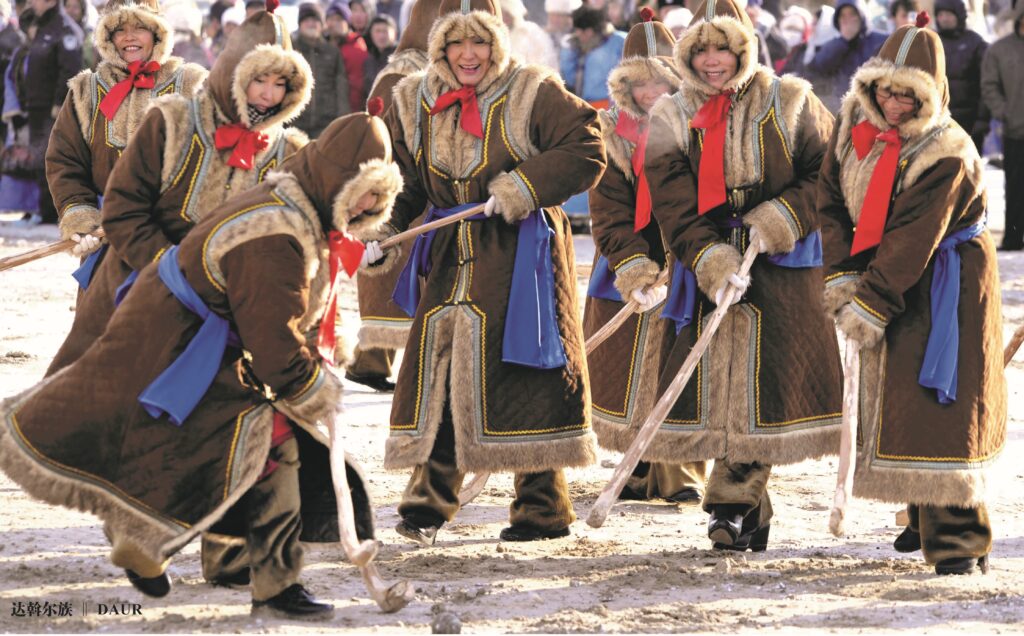
The Daur people are mainly distributed in the Molidawa Daur Autonomous Banner in Inner Mongolia Autonomous Region, the Meris Daur District of Qiqihar City and the Ewenki Autonomous Banner in Heilongjiang Province. Hala is the name of a Daol clan, which is a social group formed by the patriarchal blood relationship. The Daur people is one of the ethnic minorities with relatively developed agricultural and animal husbandry culture in northern China, who are focused on agriculture, animal husbandry, fishing, and hunting. The Daur people are good at singing and dancing, and their folk music is with many forms such as mountain songs, duikou singing (duo singing in turn), and wording dance. (Photo by Li Xin, journalist of Xinhua News Agency)
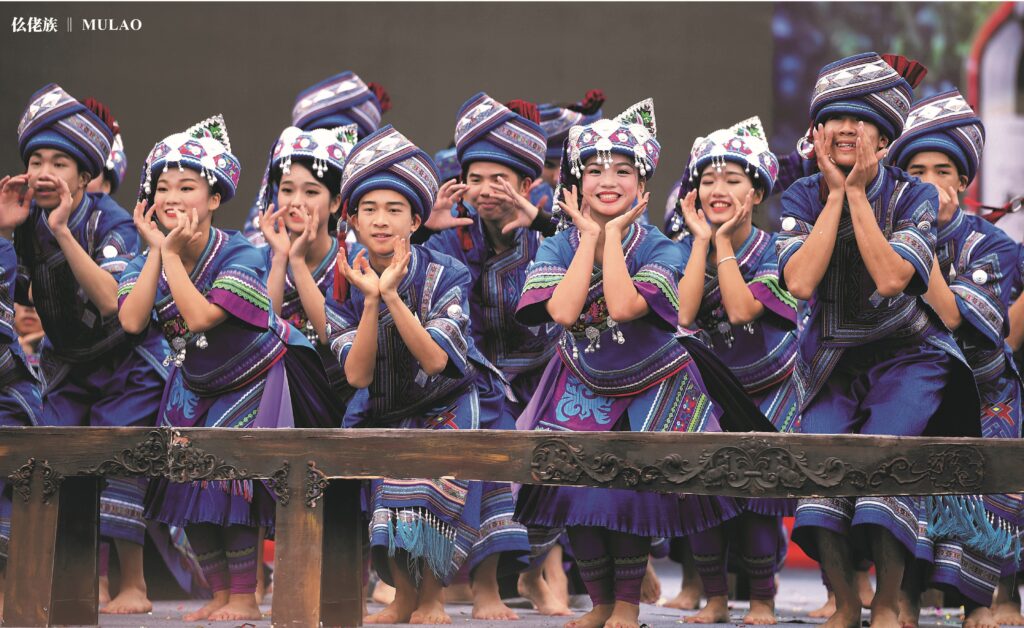
The Mulao people are mainly distributed in the Guangxi Zhuang Autonomous Region, and also live in Guizhou Province. The Mulao people live in clans, and people in the same clan often live in the same village. Clothes in dark blue color are favored by the Mulao people, with a simple and plain style. Men usually wear long trousers and duijincoats, with the left side of the front closure jointing but not overlapping with the right side. Women usually wear short, piped coats with a large front and wide sleeves, embroidered tube skirts or trousers, and blue cloth aprons. They like wearing a variety of gold and silver accessories. (Photo by Lu Bo’an, journalist of Xinhua News Agency)
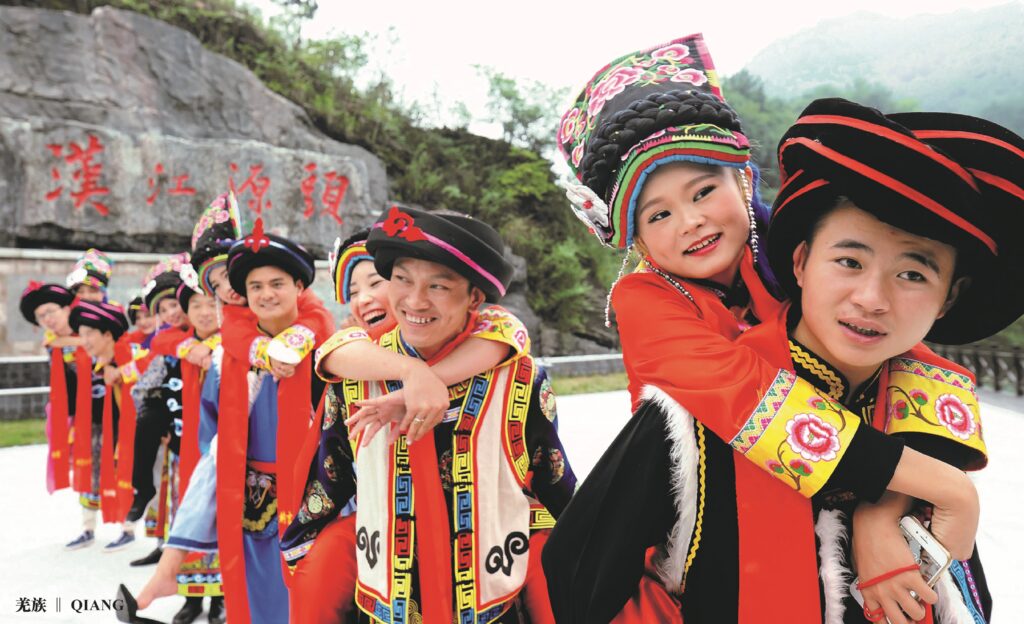
The Qiang ethnic is an ancient people in western China, who is mainly distributed in the Aba Tibetan and Qiang Autonomous Prefecture of Sichuan Province and is known as “the people above the clouds”. The Qiang folk crafts are unique, of which the cross-stitch work and embroidery are the best features. The Qiang costumes are simple and beautiful. Both men and women wear heads carves and cotton or brocade gowns that resemble cheongsam. Middle-aged and elderlies usually wear clothing in single blue and black color, while most of the young girls’ clothes are colorful. (Photo by Li Dehua, Xinhua News Agency)
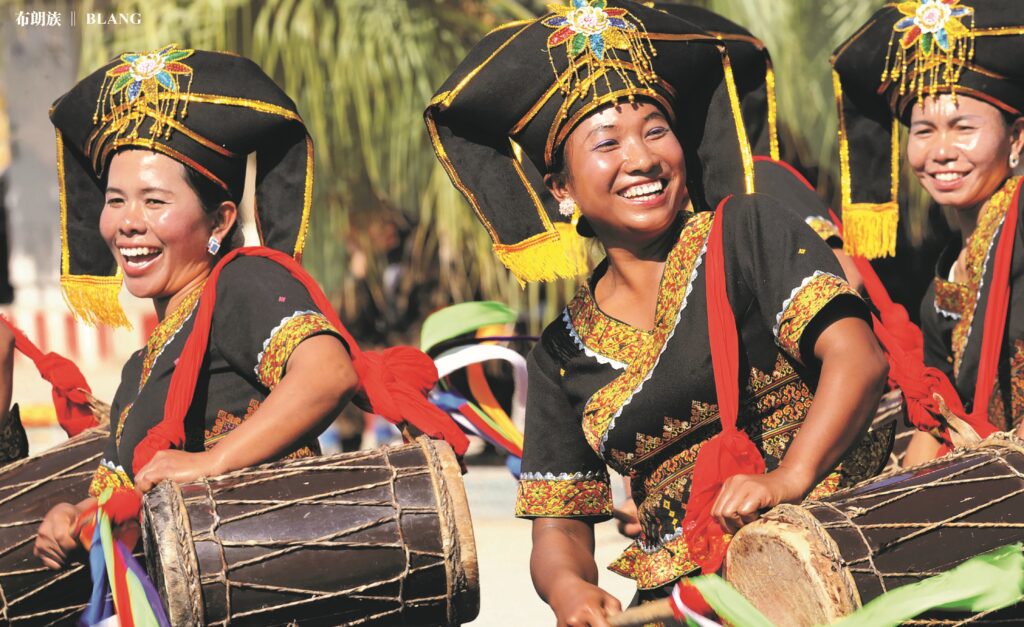
The Blang people mainly live in the mountains and forests in the border areas in western and southwestern Yunnan Province. Its rich culture has long been passed through continuously, including ethical language, costumes, songs, dance, customs and habits. The Blang people usually wear black and blue costumes. Young men wear headscarves. Elderlies like to grow long hair and braid it or top of their heads covered with white headscarves. Women all bun their hair on top of their heads, and young girls use thread spikes and pompoms made of colorful silk and woven thread and to decorate their earrings. (Photo by Chen Haining, journalist of Xinhua News Agency)
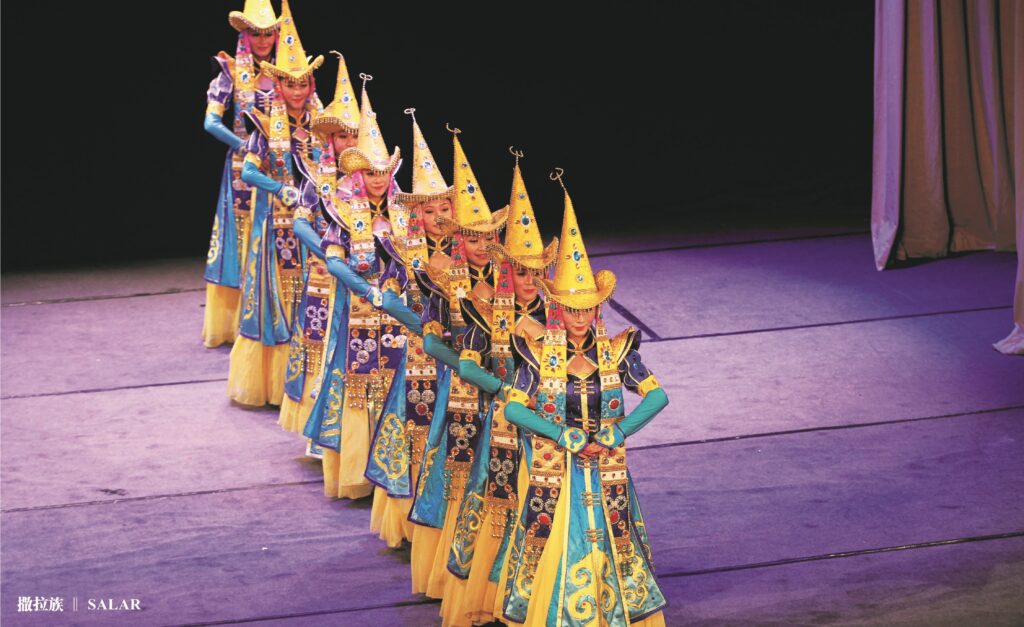
The Salars mainly live in Qinghai Province and Gansu Province, and sporadically in Xinjiang. The Salar people are deeply influenced by Islam in social life, customs and habits. The Salar men wear brimless white or black Liuya caps or small round hats, and white, short coats with blue vests. Women like brightly colored, flowered coats with a large front, and usually wear Gaitou (a special headscarf), long strings of earrings, rings, bracelets, beads strings, and other hand accessories. (Photo by Huang Ling, journalist of Xinhua News Agency)
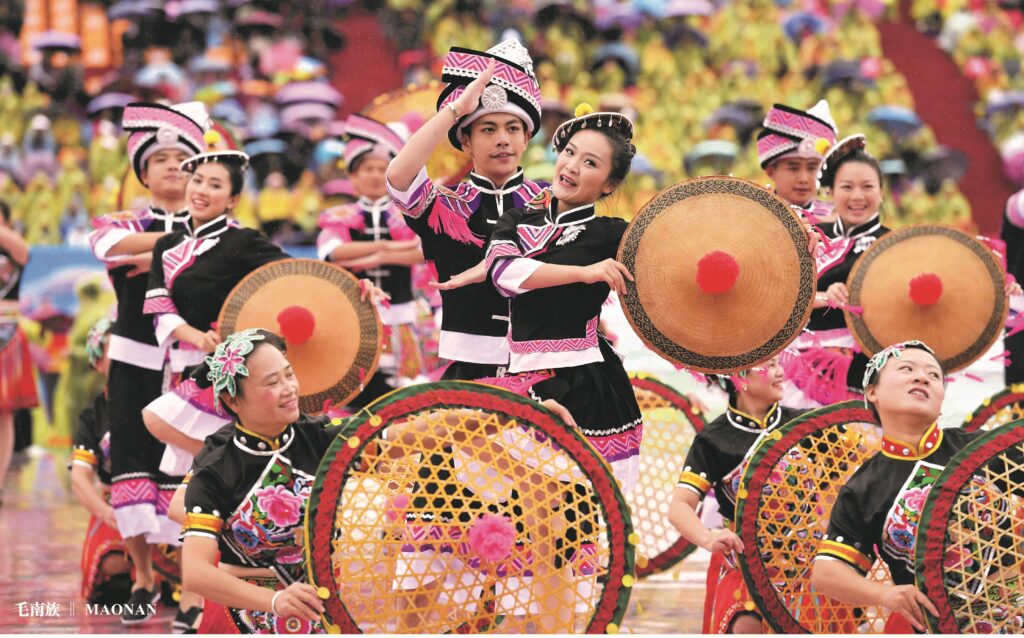
The Maonan people mainly live in the Shangnan, Zhongnan, and Xianan mountainous areas in Huanjiang County, Guangxi Province. The Maonan people has formed unique customs and habits, and colorful culture and art. Its costumes are similar to their neighboring Zhuang people and Mulao people and both men and women wear coat with a large front or with duijin (the left side of the front closure jointing but not overlapping with the right side). Men’s clothing is called five-button clothing, without lace, while the most outstanding features of women’s clothing are their three parallel, black laces decorated on their trousers and their left-opened tops. Young girls also wear a small rectangular waist band embroidered in beautiful patterns. (Photo by Zhou Hua, journalist of Xinhua News Agency)
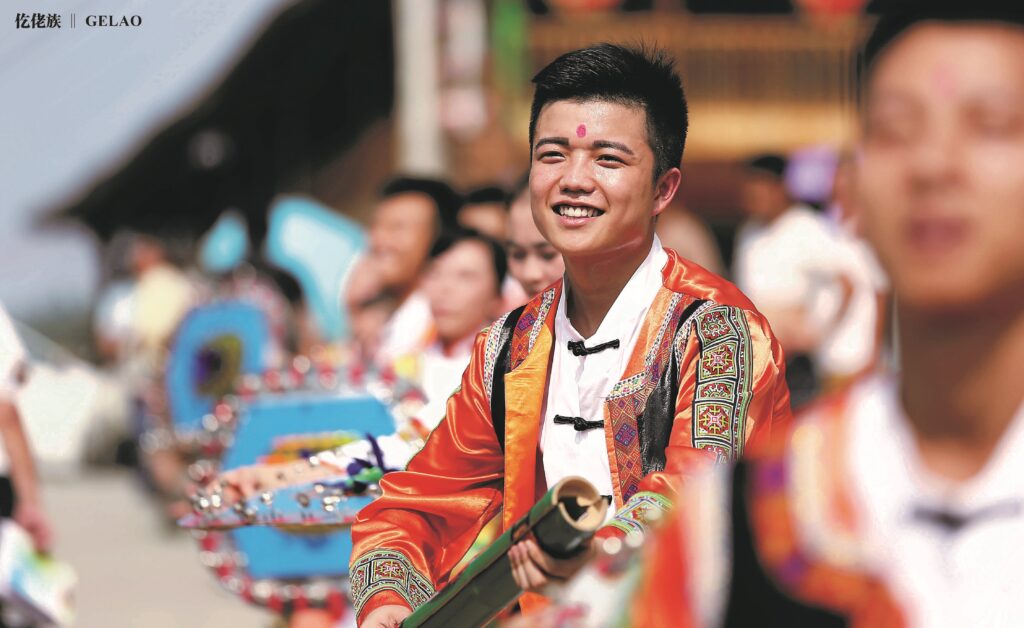
Most of the Gelao people are living in Wuchuan and Daozhen, the two Gelao and Miao Autonomous Counties and Shiqian County in the northern part of Guizhou Province. Due to its living in the mountains, the Gelao people’s clothing, food, shelter, and transportation are closely related to the mountains and forests. They still continue their worship of gods, such as the Bamboo King, the Ancestral King, and mountain gods. The traditional Gelao costumes are made of home-woven linen dyed in green and blue. Men wear collarless gowns, with Chaojin (a special type of coat front), down to below the knee. Women wear short coat, with Chaojin, decorated with lace. (Xinhua News Agency)
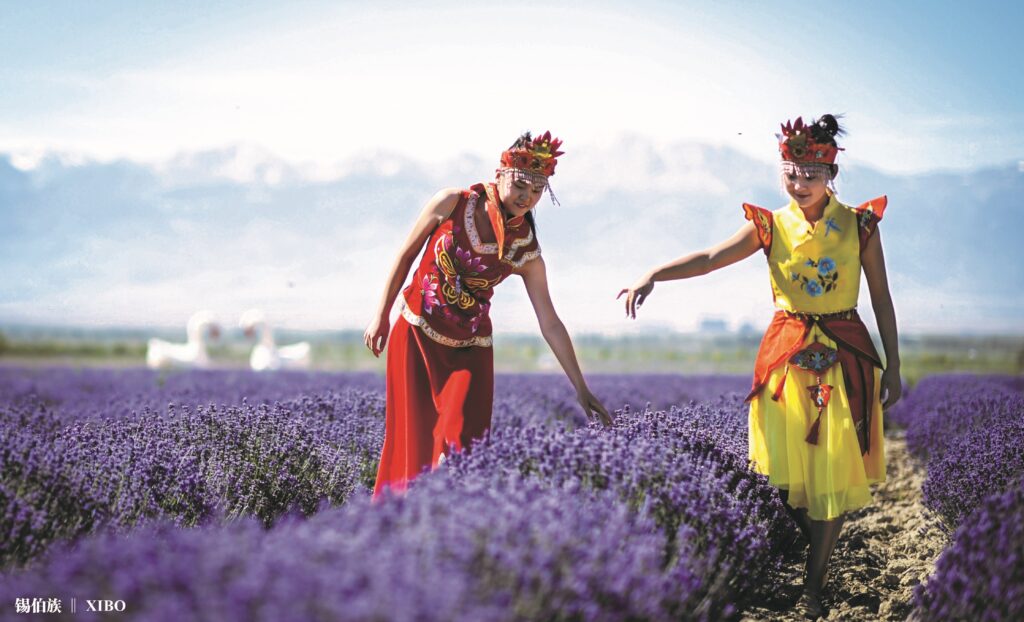
The Xibo people is an ethnic group with a long history among ethnic minorities in China, who mainly lives in the Northeast China, Xinjiang and Inner Mongolia Autonomous Region. The traditional religions of Xibo people are Shamanism and Buddhism, and they mainly worship the Haili Mamma and the Haier Khan Mafa that protects livestock. The traditional costumes of the Xibo people absorb the features of the costumes of Mongolian, Manchu, Han and other peoples. Men wear robes in blue green, gray, and brown, with thick bottom shoes for riding horses, and women like to wear a variety of cheongsams (mostly piped) made in colorful cloth and gingham, embroidered shoes, and vests, etc. (Photo by Zhao Ge, journalist of Xinhua News Agency)
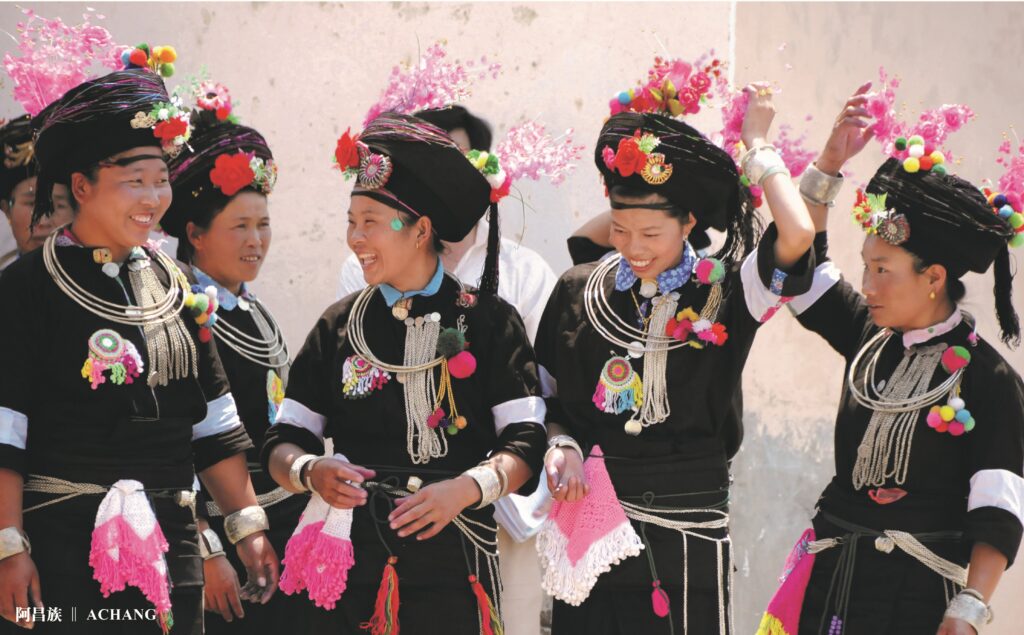
The Achang people is one of the less populous ethnic minorities living in Yunnan’s only, who is mainly distributed in the Dehong Dai and Jingpo Autonomous Prefecture in Yunnan Province. The ironware made by the Achang people is extremely famous, of which the Husa knife is well known. The Achang traditional costumes are unique. Men usually wear blue, white or black duijin coat with the left side of the front closure jointing but not overlapping with the right side, and black trousers, while women’s clothing varies from place to place. The traditional costumes for girls are light-colored duijin coats with the left side of the front closure jointing but not overlapping with the right side and dark trousers. Girls pin their braids on the top of the head with flowers. (Photo by He Lulu, Xinhua News Agency)
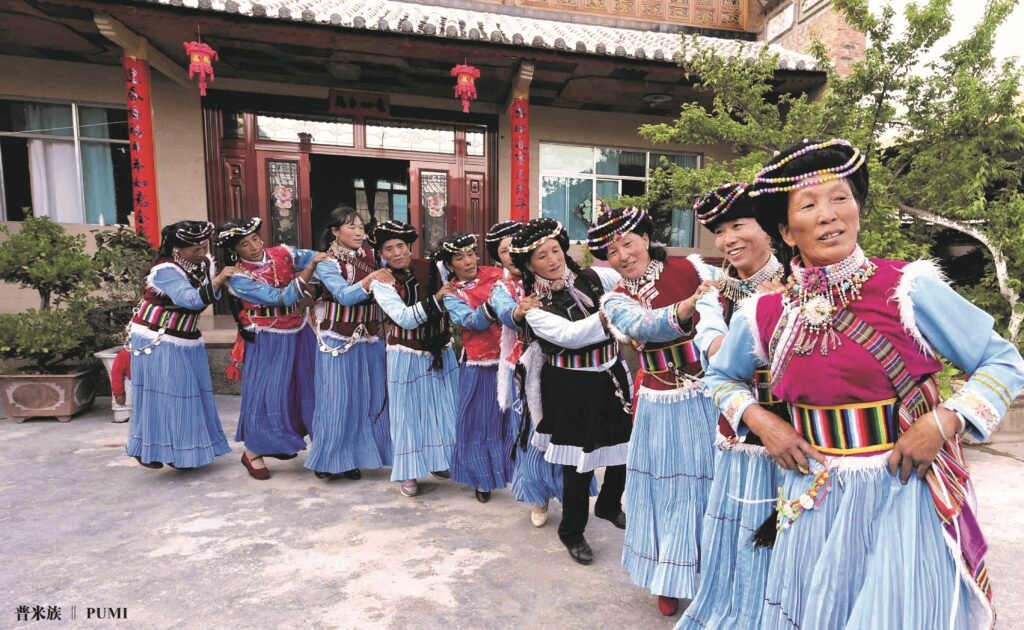
The Pumi people are mainly distributed in the northwestern Yunnan and southwestern Sichuan. The Pumi people are originally nomadic people, who are good at breeding and grazing, and their traditional craft industry includes textiles, leather and iron making, winemaking, oil extraction, and bamboo weaving. The painted wood bowls in Ninglang area are well-made and well-known. The Pumi costumes are mostly preserved in the Ninglang region. Women wear piped coats with a large front and headscarf, and men wear linen short coats and loose trousers. (Photo by Yang Zongyou, journalist of Xinhua News Agency)
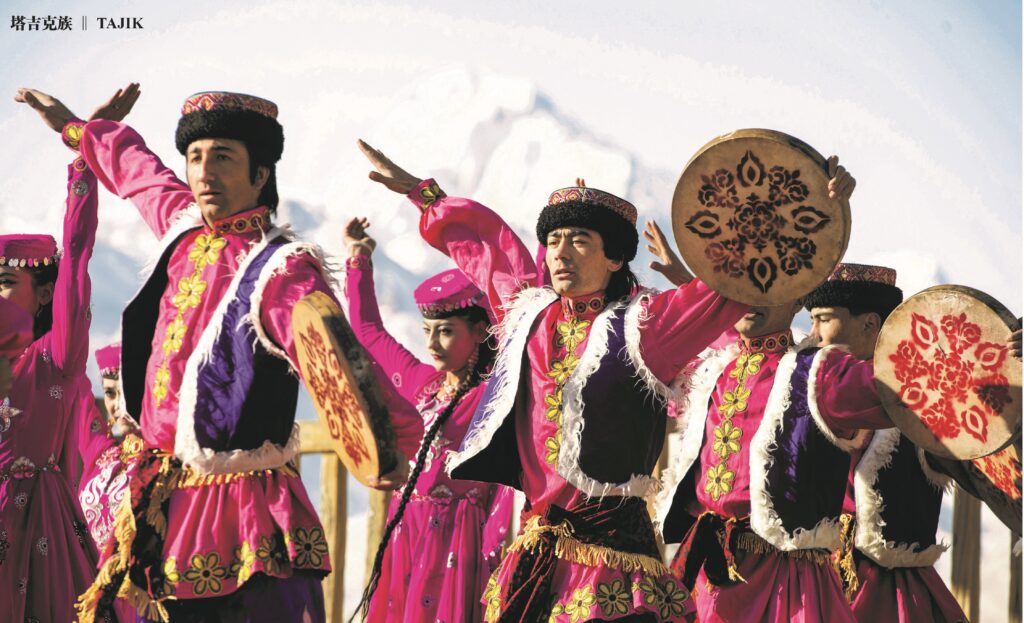
The Tajik people in China mainly live in the Taxkorgan Tajik Autonomous County in the Xinjiang Uyghur Autonomous Region, whose traditional belief is Islam. The Tajik people are good at singing and dancing, with eagle dance as the most famous one. Tajik adult men usually wear a black velvet, high-grade Tumake hat embroidered with patterns, and the inner part is sewn with high-quality black lambskin. Women’s costumes and accessories are splendidly colorful. They usually wear one piece dresses and trousers, and Kuleta, a thick and embroidered dome hat, which is an important symbol for Tajik women to be distinguished from those of other ethnic groups. (Photo by Jiang Wenyao, journalist of Xinhua News Agency)
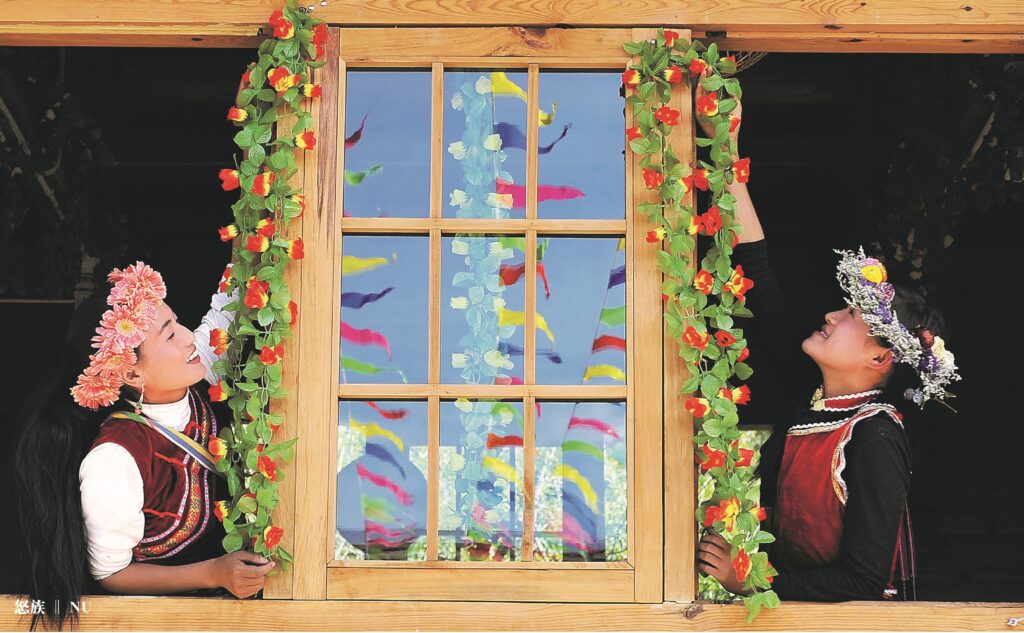
The Nu people are mainly distributed in the Nujiang Lisu Autonomous Prefecture of Yunnan Province, who traditionally believe in primitive religion and believe that everything is with its own spirit. Because of living in the Nujiang River Grand Canyon with precipitous rocks and roaring water, the Nu people can only rely on Liusuo, an ancient rope instrument to cross the river from the above. Men and women of Nu people usually wear linen clothes, and women like to use coral, agate, shells, silver coins and so on to make beautiful headwear and chest ornaments. (Photo by Zou Zheng, journalist of Xinhua News Agency)
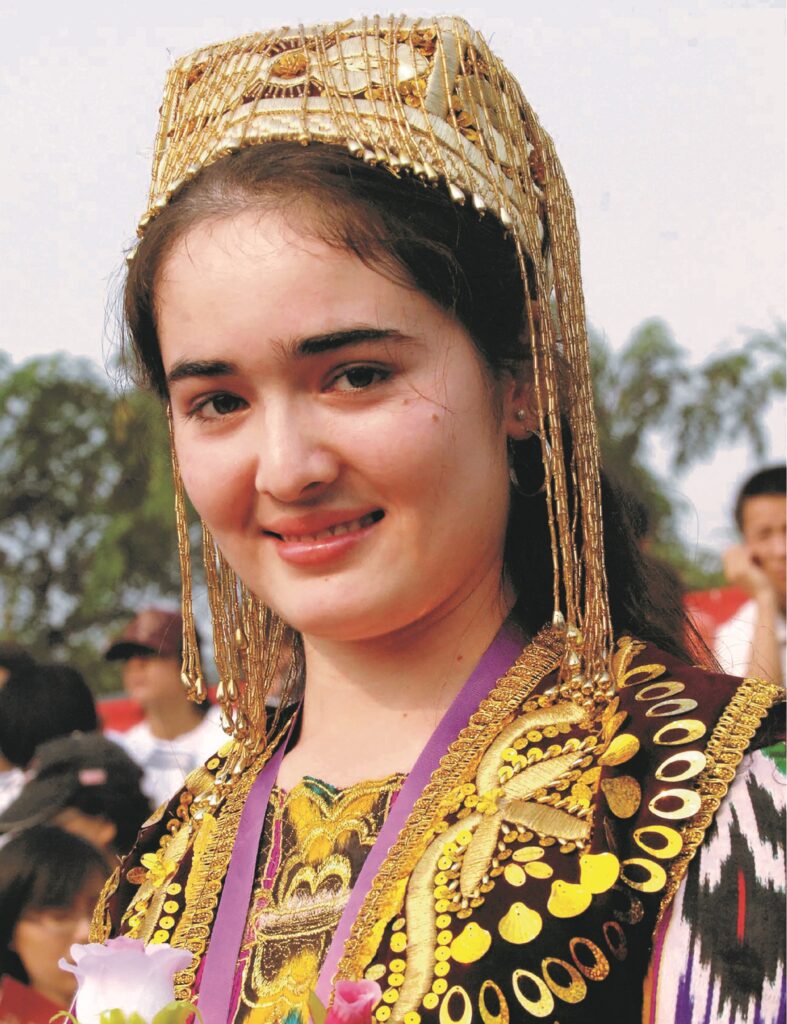
The Uzbek people are distributed from both China and abroad with same origin, those of which in China are scattered in many counties and cities in the Xinjiang Uyghur Autonomous Region. Their costumes are with special and unique Uzbek style, and both men and women wear a variety of hard-shelled bonnets. Men usually wear patterned gowns and women wear Kuilak dresses whose features are wide, pleated, and in bright colors. The Uzbek people are good at singing and dancing, and their traditional tambourine dance is with unique feature. (Photo by Shen Qiao, journalist of Xinhua News Agency)
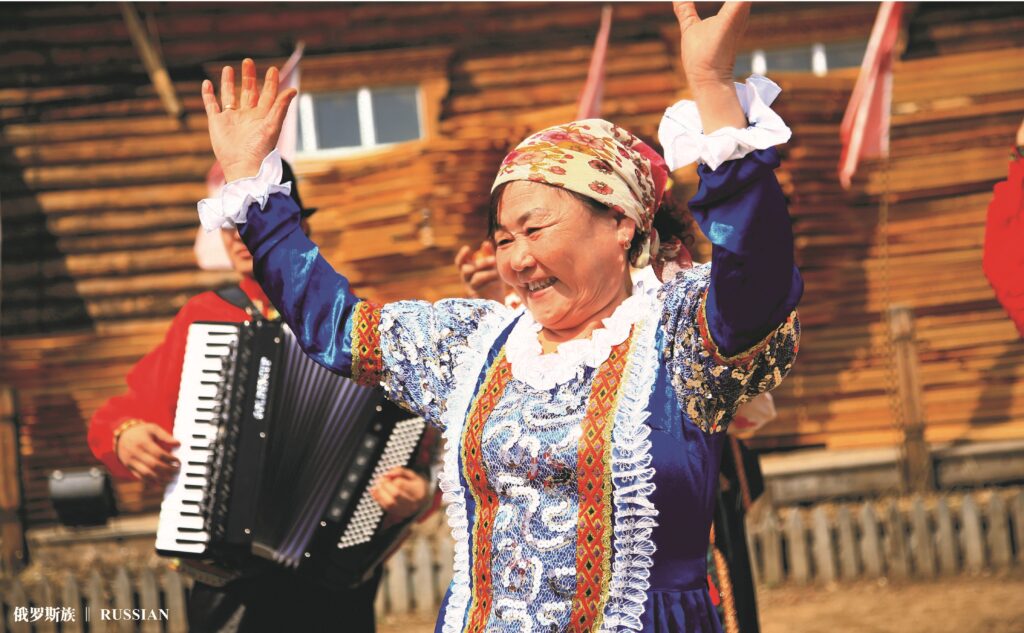
The Russian people in China mainly live in Xinjiang and Inner Mongolia, with Orthodox as their traditional belief. The Russian people in China are descendants of ancient Russian immigrants. After hundreds of years of cultural integration, they have gradually formed their own characteristics, with unique ethnic craftsmanship and long-lasting folk literature. Men wear linen shirts with slanted collar, woolen coats, belts, thin trousers and long boots, while women wear burlap shirts with pleated collar, covered with sleeveless robes, the Sarafan, or self-woven woolen skirts. (Photo by Zou Jianpu, journalist of Xinhua News Agency)
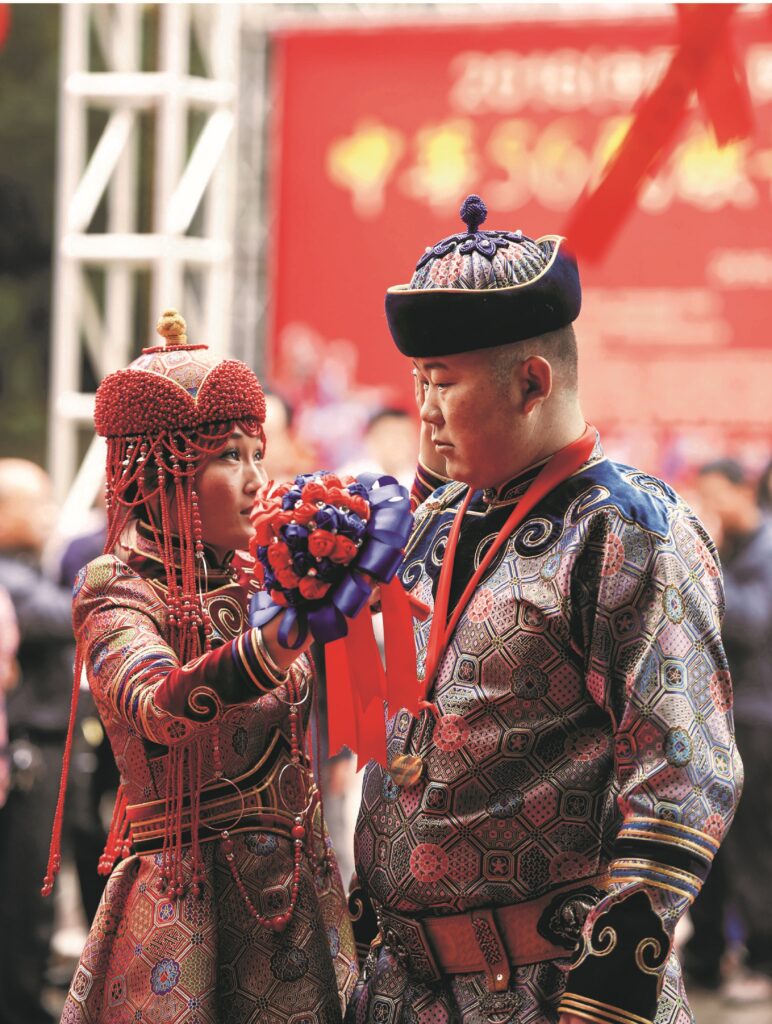
The Ewenki people mainly live in the Inner Mongolia Autonomous Region. “Ewenki” means “people living in large mountain forests”. From nomadism to settlement, they have always been engaged in animal husbandry. Ewenki ethnic culture is rich with a long history of reindeer culture. Life utensils are made of birch bark. Its traditional costumes are mainly made of leather. Winter robes, trousers, boots, hats, and gloves are made of roe deer skin, deerskin and sheepskin, etc., and in different places the Ewenki costumes have their own characteristics. (Photo by Mao Siqian, journalist of Xinhua News Agency)
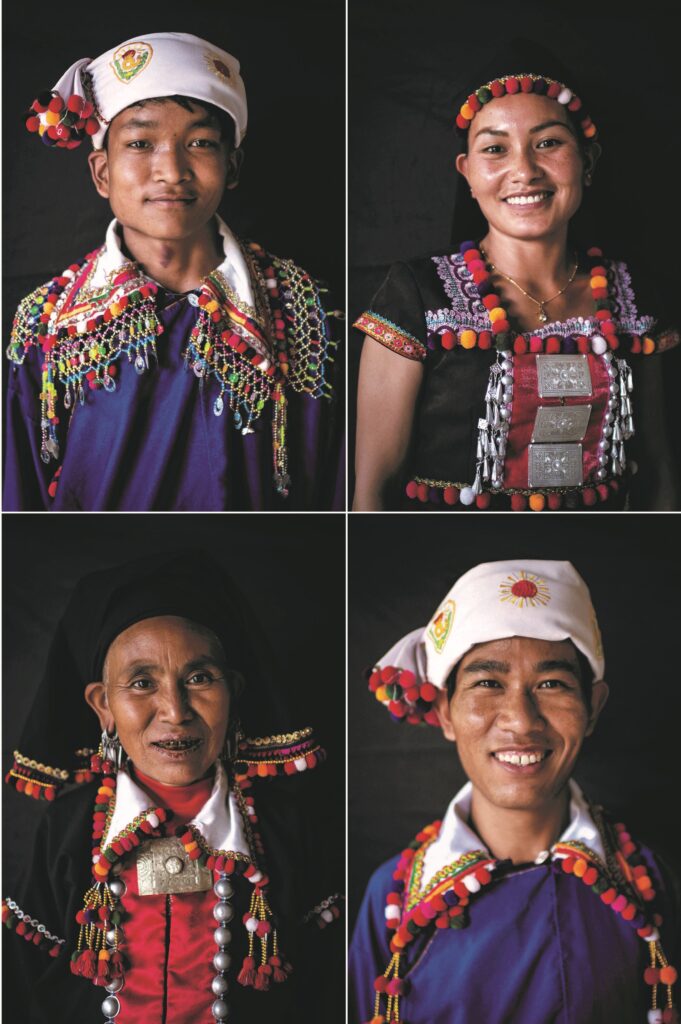
The De’ang people, also known as the Benglong people, is an ethnic minority in the China-Burma border area. The De’ang people in China mainly live in bamboo buildings in mountains in Dehong, Baoshan, and Lincang in Yunnan Province. The traditional religion of the De’ang people is Buddhism, with its own Buddhist temple in almost every village. The De’ang costumes have a strong feature of its own, out of which the most striking one is the women’s waistband. When a girl grows up into an adult woman, she will wear several or even dozens of rattan waistbands around the waist. (Photo by Pan Chaoyue, journalist of Xinhua News Agency)
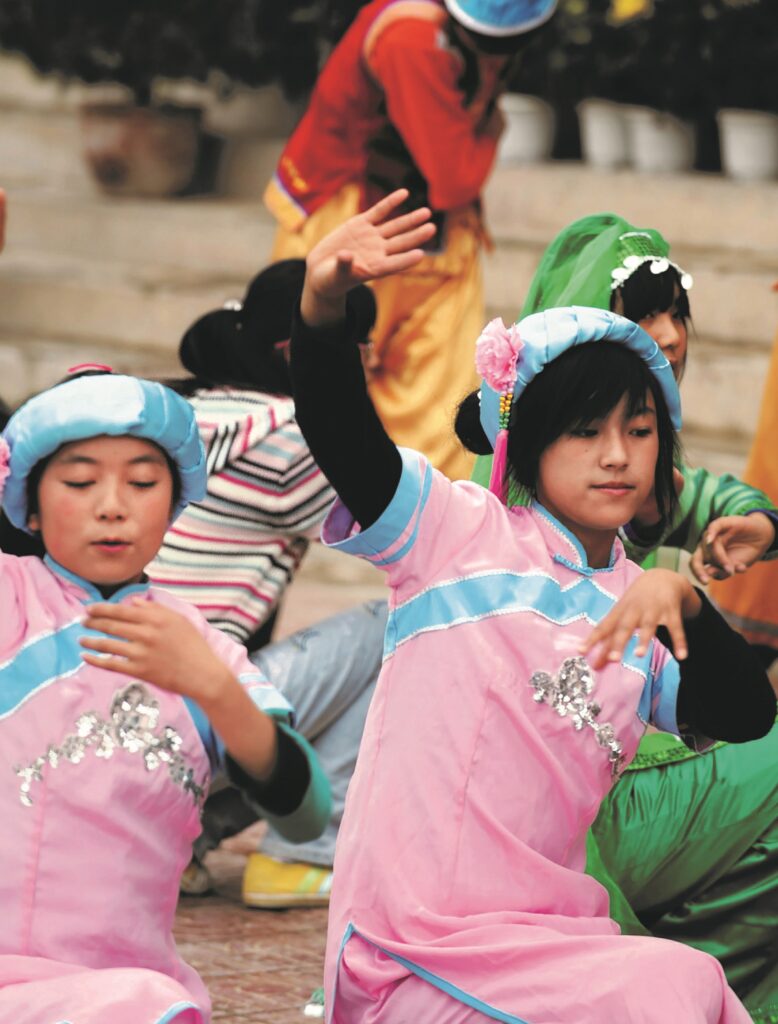
The Bao’an ethnic group is one of the ethnic groups with a small population in China, who mainly lives in the Linxia Hui Autonomous Prefecture of Gansu Province with Islam as its traditional belief. Due to the fact they neighbored the Mongol people, their costumes are similar to theirs. Men usually wear white caps, white shirts, and black vests, while women generally wear hijabs, colorful coats with left front crossing over the right, and vests with embedded laces. (Photo by Zhang Meng, journalist of Xinhua News Agency)
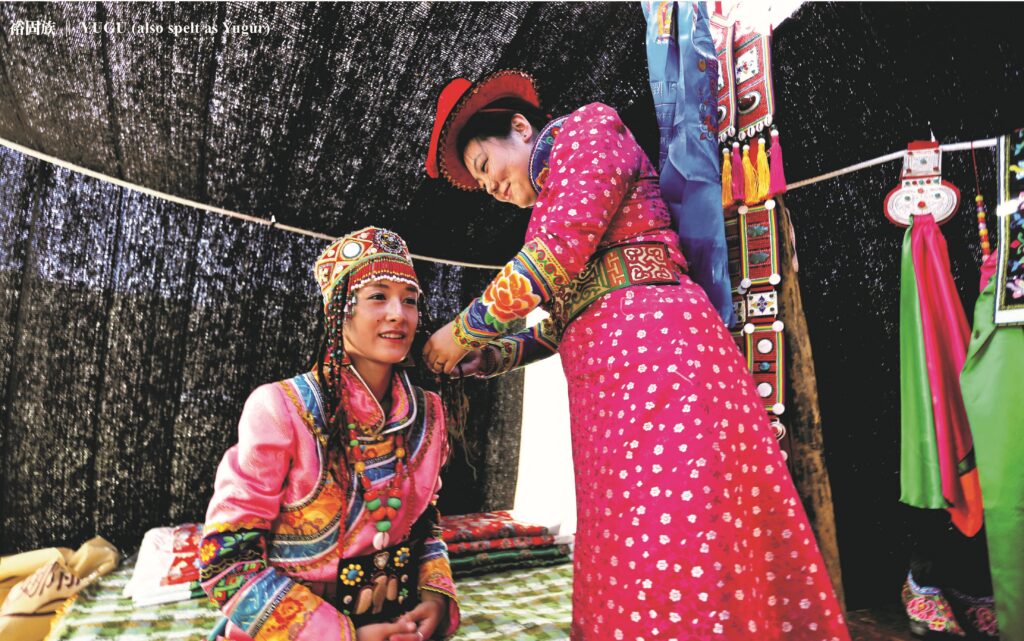
The Yugu (also spelt as Yugur) people mainly live in Gansu Province and is an ethnic group focused on animal husbandry. The Yugu people originated from the ancient nomadic Uyghur of the Tang Dynasty in the Orkhon River Basin, most of whom used to believe in Shamanism or Manichaeism but now in Buddhism. Yugu men and women wear high-necked robes with a large front. Men wear felt hat, belt, and high boots, and women wear high-necked robes with separated bottom hem and embroidered lace. (Photo by Wang Jiang, Xinhua News Agency)
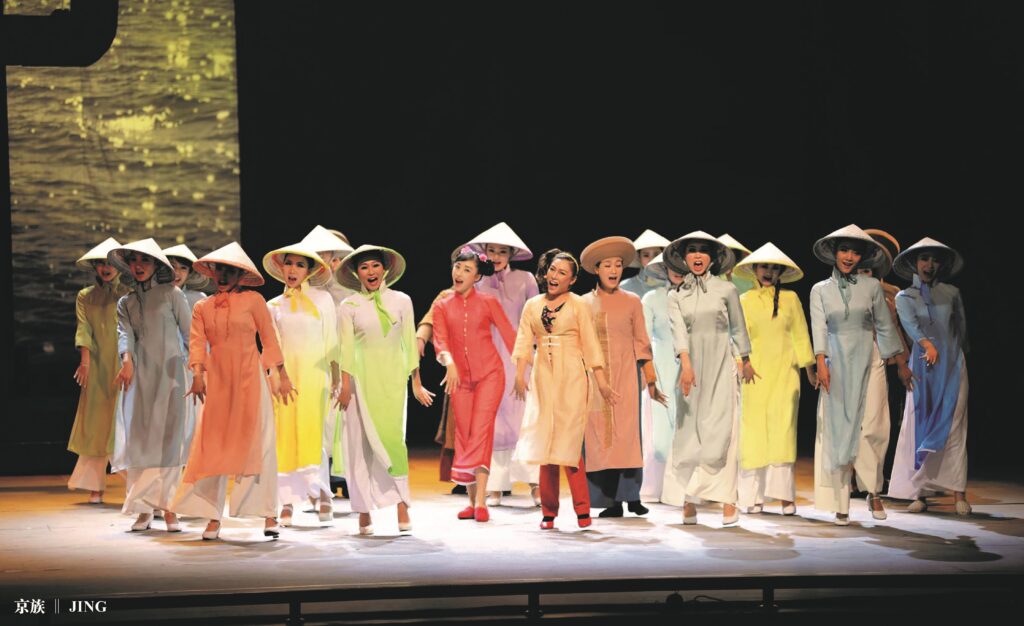
The Jing people of China is mainly distributed in Fangchenggang City of Guangxi Zhuang Autonomous Region, who is a less populated group in the ethnic minorities in China. Their ancestors migrated from Vietnam. Most of them depend on fisheries for a living. The Jing people’s costumes are simple and beautiful, and wearing long gowns and conical hats is one of the typical symbols of the Jing people. (Xinhua News Agency)
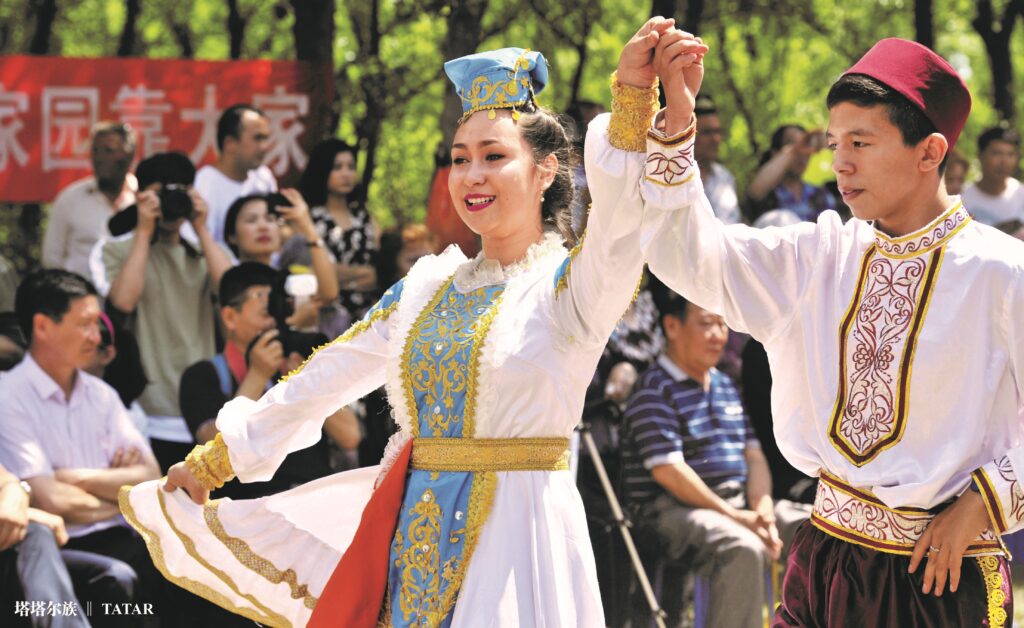
The Tatar people in China are mainly scattered in the northern part of the Tianshan Mountains in the Xinjiang Uyghur Autonomous Region, with a relatively less population among the ethnic minorities in China. The Tatar women are good at embroidering, whose clothing is with geometric patterns, such as crosses and diamonds, embroidered on the neckline, cuff and chest of their shirts. The Tatar traditional belief is Islam, with major traditional festivals the Eid al-Fitr, the Eid Adha, and the Saban Festival. (Photo by Hu Huhu, journalist of Xinhua News Agency)
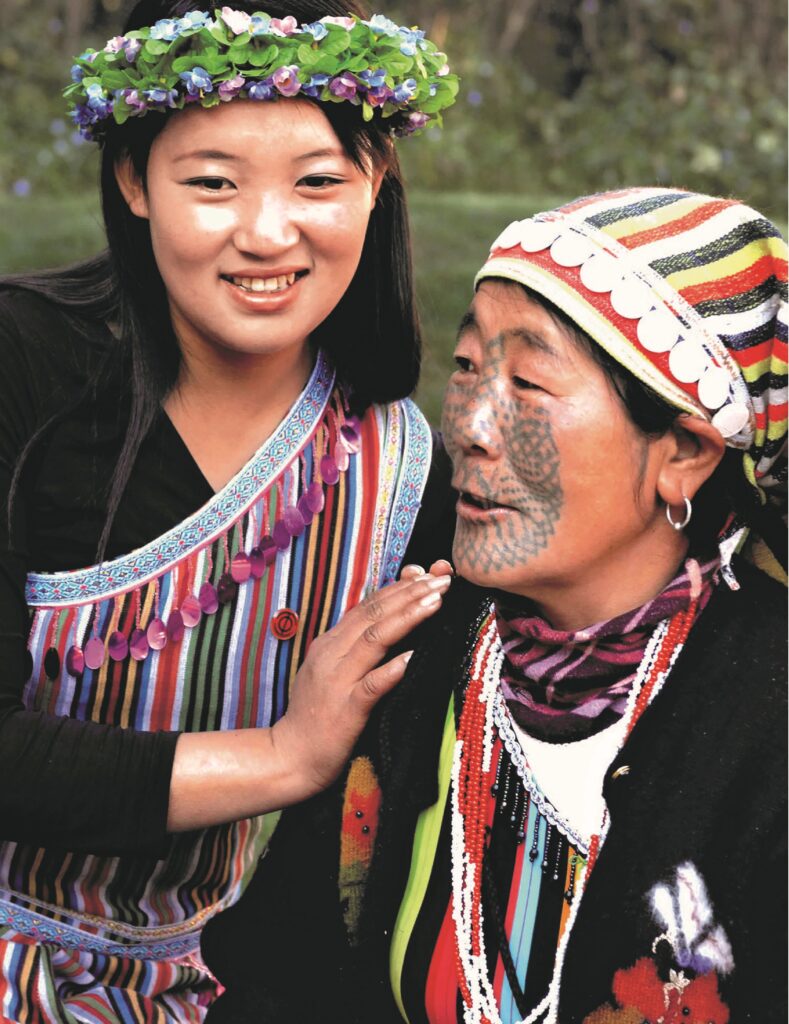
The Dulong (also spelt as Derung) people in China are mainly distributed on the banks of the Dulong River Gorge in Yunnan Province and on the banks of the Nu River in the north, who mainly engage in agriculture, harvesting, and fishing. The traditional costume of the Dulong people is a unique Dulong carpet woven in threads in five colors, which could be pulled from the left shoulder across the chest. The Dulong men and women do not tie their hair, and girls have the customs of face tattooing. (Photo by Zhou Zhongyao, journalist of Xinhua News Agency)
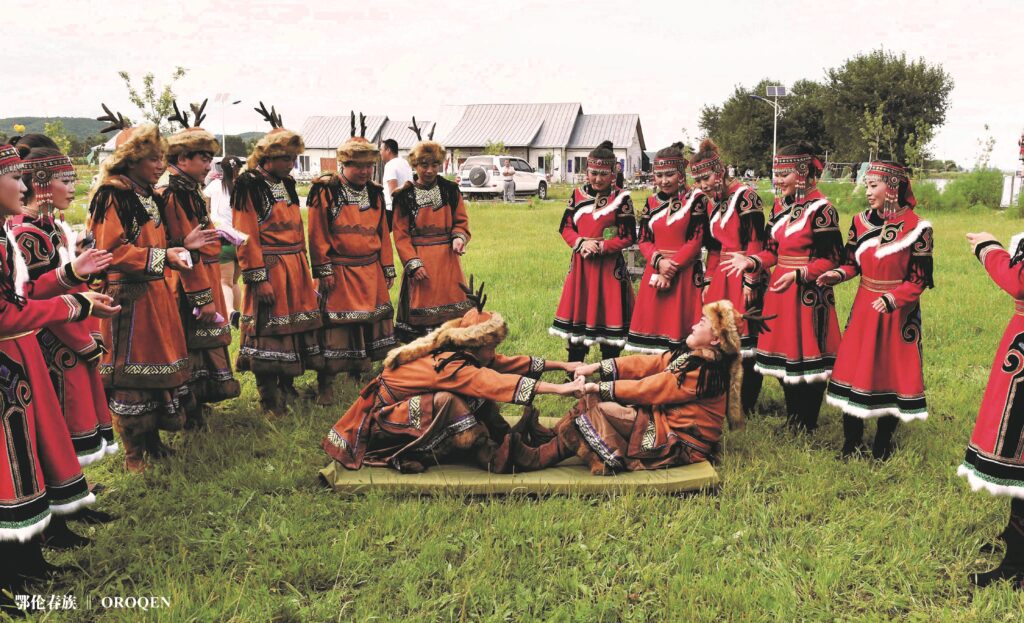
The Oroqen ethnic group is mainly distributed in Heilongjiang and Inner Mongolia, and is one of the less populous ethnic groups in northeastern China. It is a hunting people. Thus its lifestyle reflects a strong hunting culture. Their costumes are mostly made of deerskin, roe deer skin, and lynx skin, and are often decorated with embroidery, cloud and antler lines. Their traditional belief is Shamanism, and the ancestors worship and totem worship have been passed down to today. (Photo by Wang Jianwei, journalist of Xinhua News Agency)
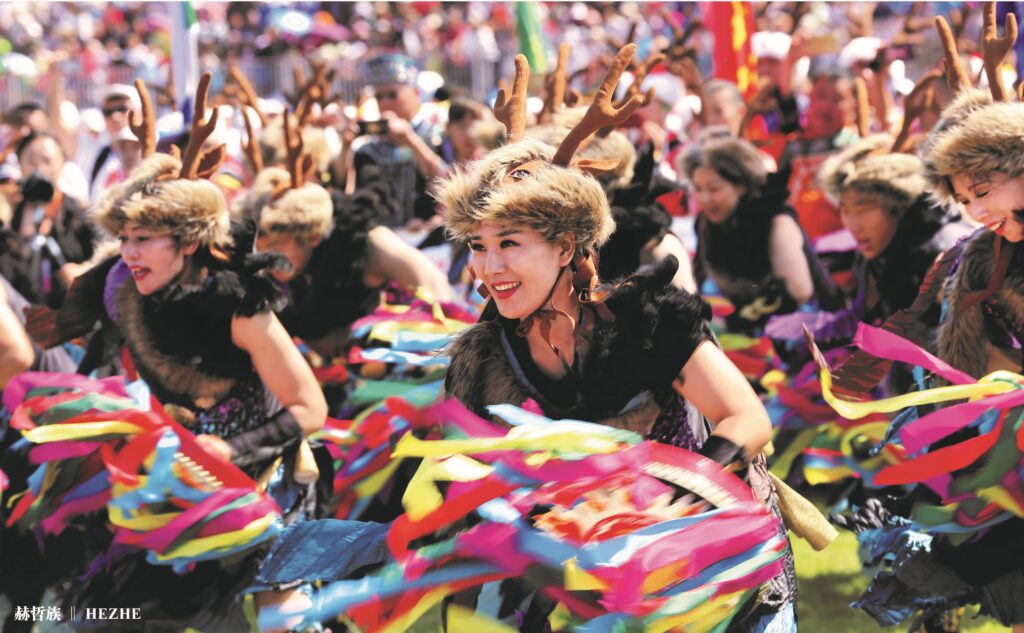
The Hezhe people are mainly distributed in the Sanjiang Plain and the Wanda Mountain in the Heilongjiang Province. It is the only ethnic group who used to focus on fishing in the ethnic minorities in northern China. The Kouxianqin (a special chord) is a traditional instrument of the Hezhen people, whose traditional dance also simulates scenes of fishing, hunting, and fighting. The Hezhe people wear traditional clothing embroidered with cloud patterns, geometric patterns, flowers, butterflies, etc. They also cut fish and animal skin into various dyed patterns. (Photo by Xu Congjun, Xinhua News Agency)
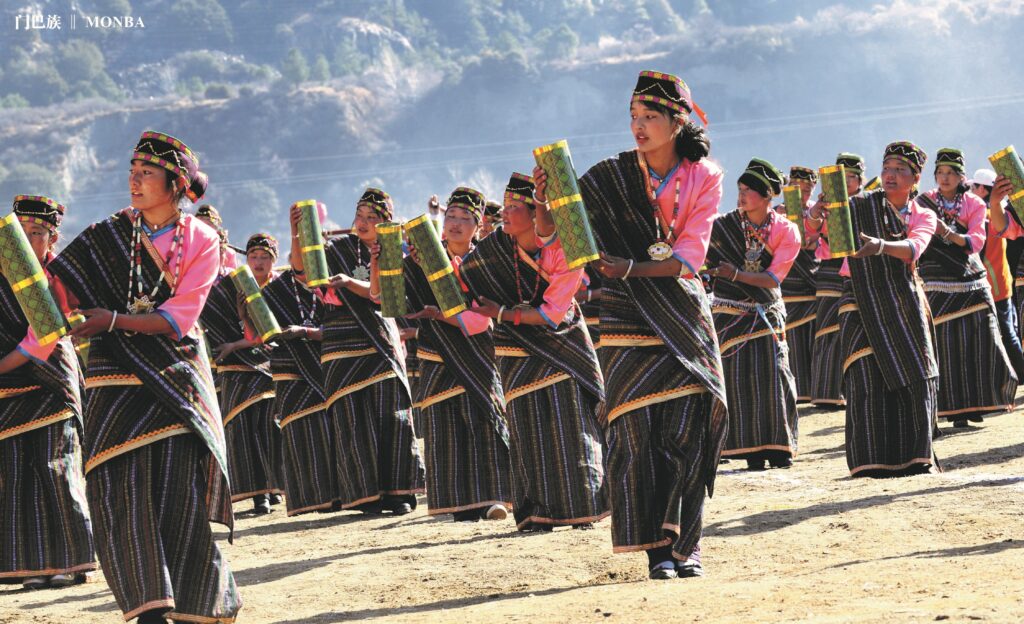
The Monba people are mainly distributed in the Menyu and Metuk areas in the southeast of the Tibet Autonomous Region, who mainly engage in agriculture, animal husbandry, and traditional craft industry. The Monba people’s most developed industry is bamboo and wood crafts making, out of which the Monba wooden bowl has long enjoyed a high reputation. The Monba women’s costumes are colorful, most of which are made of dyed Puluni, a local wool suiting. (Photo by Kelsang Dawa, journalist of Xinhua News Agency)
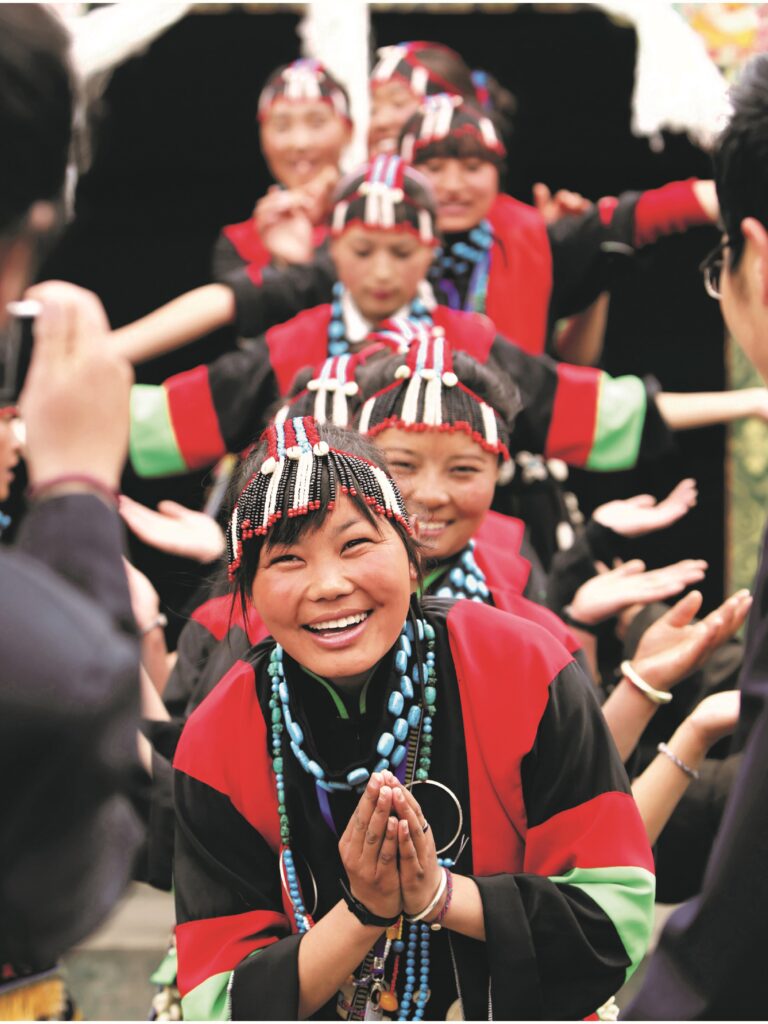
The Lhoba people are mainly distributed in the Loyu area between the Chayu and Menyu of the Tibet Autonomous Region. The Lhoba people are good at hunting, and the traditional men’s clothing also reflects the characteristics of hunting in the mountains and woods, with a black wool vest and a cowhide on the back. Men and women, especially women, like to wear accessories, weighting more than 5 kilograms when the owner dresses up. The accessories are family gains by exchange for many years and are a symbol of family wealth. (Photo by Wang Ying, journalist of Xinhua News Agency)
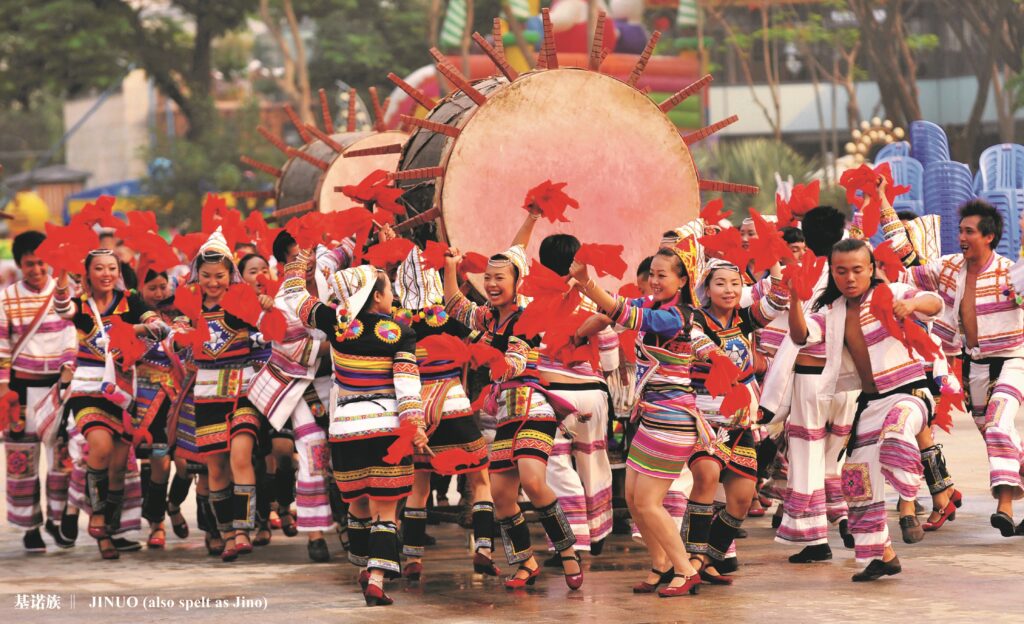
The Jinuo (also spelt as Jino) people mainly live in Xishuangbanna Dai Autonomous Prefecture in Yunnan Province, and is one of the seven unique ethnic groups in Yunnan Province with a small population. The Jinuo people do not have their own characters, and they used to engrave wood and bamboo for remembering numbers and issues. The Jinuo people wear simple costumes made in self-woven cloth with strips in blue, red, and black color. (Photo by Lin Yiguang, journalist of Xinhua News Agency)
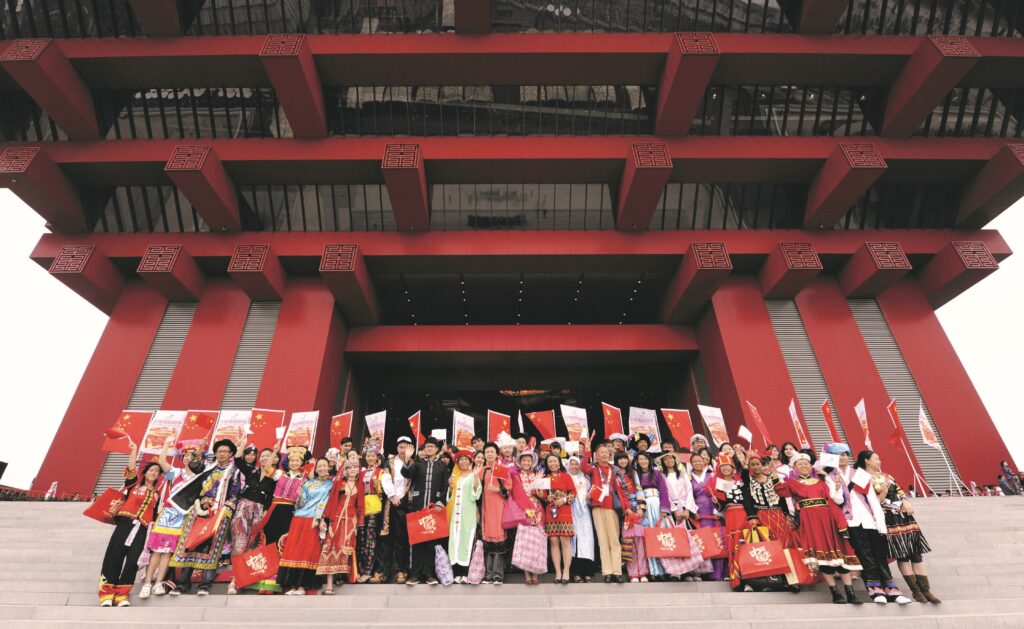
The 56 ethnic groups in China. (Photo by Guo Lei, journalist of Xinhua News Agency)
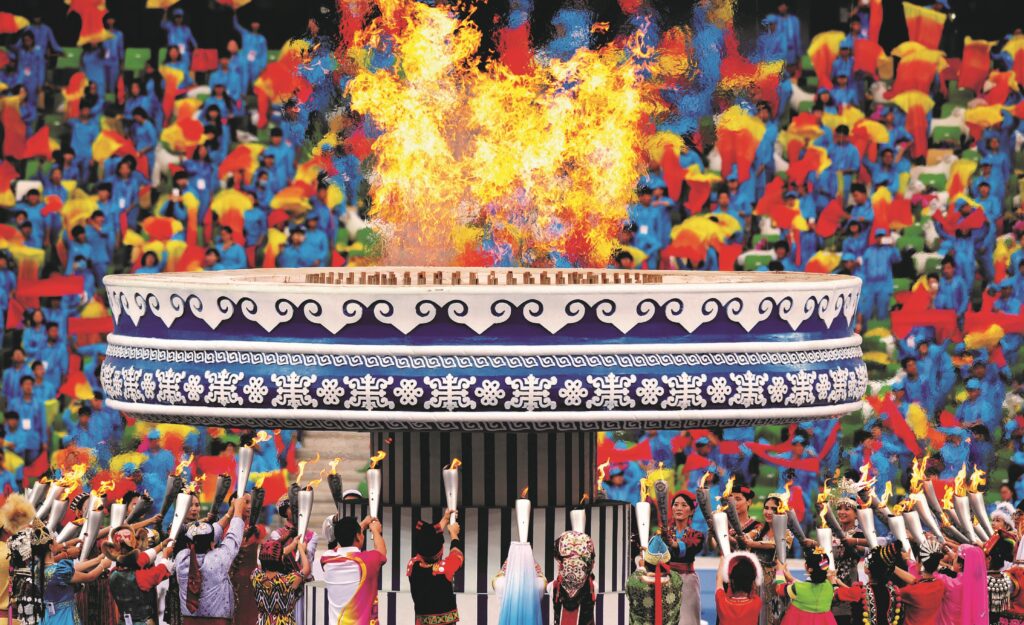
The 56 ethnic groups in China. (Photo by Lian Zhen, journalist of Xinhua News Agency)
Facebook: China Cultural Center in Stockholm
https://www.facebook.com/China-Cultural-Center-in-Stockholm-110983273921638
Instagram: chinaculturalcenterinstockholm
https://www.instagram.com/chinaculturalcenterinstockholm/
Youtube: China Cultural Center in Stockholm
https://www.youtube.com/channel/UCYqOYwuQtyTHC-iMNdfExsw
Tik Tok: cccinstockholm
@cccinstockholm
